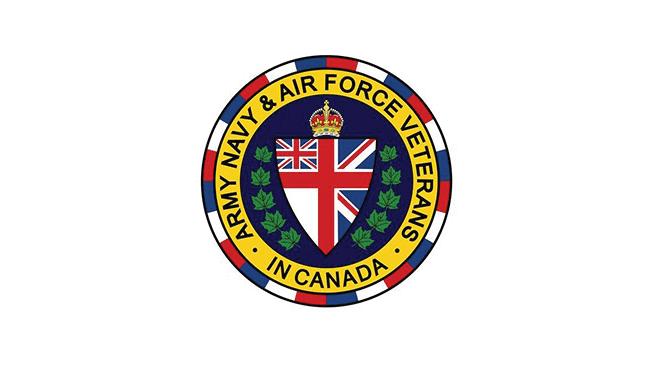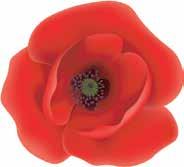














Two Famous WW Two Squadrons
The Moose Jaw Warriors Hockey Team Logo honours the current RCAF, 431 Squadron Air Demon-

stration Team Snowbirds.
431 Squadron has a storied history. The Squadron was formed in England on November 11, 1942 as 431 (Iroquois) Squadron RCAF,
By Richard Dowson
part of # 6 Group, RCAF Bomber Command.
During the War, 239 airmen from the Squadron were killed. The Squadron was disbanded in Canada on September 5, 1945.
The Squadron was Reformed in 1978. Every Moose Jaw resident is proud to have the ‘Snowbird’ Squadron based here, at 15 Wing Moose Jaw.
The Other Hockey Team
The Windsor Spitfires Hockey Team honours 417 RCAF (Fighter) Squadron, ‘City of Windsor Squadron’ from WW II.
During WW II 417 Squadron RCAF was the only Canadian Fighter Squadron operational in North Africa, Sicily and Italy. The Squadron was part of the famous “Desert Air Force” and provided tactical support for the Eight Army.
In WW II the Squadron lost 18 pilots killed, 8 taken prisoner and 2 who evaded capture. The Squadron was disbanded at the end of the War.
The Squadron was reformed and is now 417 Combat Support Squadron, based at 4 Wing, Cold Lake, Alberta. Is there a Moose Jaw connection? Of Course!
Pilot Officer Rex Probert, 929 Alder Avenue, Moose Jaw, won a D.F.C. flying with 417 Squadron in WW II. Here’s the DFC reference.
“One day in July 1943 this officer, in company with a pilot in another aircraft, engaged a formation of more than twelve enemy fighters over Catania airfield. In the engagement two of the enemy aircraft were destroyed and another was seriously damaged. Pilot Of-
By Richard Dowson
ficer Probert personally destroyed one and damaged another.” (RCAF Awards)
On another occasion Rex was ‘shot up’ and ended up in the Med-
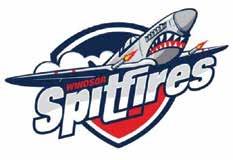
iterranean Sea. He was rescued by an RAF Air-Sea Rescue Walrus aircraft on its third and final attempt. He was granted leave, came back to Moose Jaw and got married. Rex died in 2014.
On Remembrance Day (Armistice Day) November 11, remember the Saskatchewan soldiers killed while serving with Moose Jaw’s 46th ‘Suicide’ Battalion in World War One.
The 46th Battalion had a casualty rate of 91.5%. Of this, 3,484 were wounded and 1,433 killed.
Many of these young men went to war willingly. Some enlisted because of social pressure and many, after 1916, were conscripted and had no choice.
Relatives of those killed received financial compensation called a “War Service Gratuity”. It was paid to parents or the wife of the man killed. The amount paid for each soldier killed

averaged about $100.00. In today’s money, that is about $1,681.00 per dead soldier.

BY JOHN MCCRAE
In Flanders fields the poppies blow Between the crosses, row on row, That mark our place; and in the sky
The larks, still bravely singing, fly Scarce heard amid the guns below.
We are the Dead. Short days ago We lived, felt dawn, saw sunset glow, Loved and were loved, and now we lie, In Flanders fields.
Take up our quarrel with the foe: To you from failing hands we throw
The torch; be yours to hold it high. If ye break faith with us who die We shall not sleep, though poppies grow In Flanders fields.

As a follow-up to an item in the Moose Jaw Express asking for information on Flight Lieutenant Lorne Pritchard, D.F.C. I searched and found the following information in the old Moose Jaw Times Herald dated December 31, 1941:
“Sergeant W.C. Pritchard, R.C.A.F.M.C., MacLeod, Alberta (Lorne Prichard’s Father), and Corporal L.T. Pritchard, R.C.A.F.M.C., Currie Barracks, Calgary, spent Christmas at their home, 229 High Street East. They were accompanied by Aircraftsman T. Bradley and Aircraftsman Cyril Brucher of the Royal Australian Air Force.”
I got side-tracked and researched the Aussies.
I was unable to track down Aircraftsman T. Bradley, RAAF but did find Cyril whose name had been misspelled in the news item.
Flight Lieutenant Cyril Wallace Burcher, 411737, DFC, Royal Australian Air Force. Cyril survived the war. I am sure he had fond memories of his 1941 Christmas in Moose Jaw.
I found Cyril’s Service Record and he was at No. 3 SFTS Calgary in November 1941. Cyril had completed his Elementary Flying Training in Australia and left Sydney October 16, 1941 for Canada, arriving in Calgary in November 1941.
Cyril and Lorne were both at No. 3 S.F.T.S., Calgary together. Cyril was training to be a pilot and Corporal Prichard was working as a Nursing Orderly.
By Richard Dowson


Lorne enlisted in the RCAF at Calgary on December 10, 1940 and was immediately posted as a Corporal to No. 3 S.F.T.S., Calgary. Although conjecture, this suggests Lorne was working as a Nursing Orderly before joining the military.
1941 was Bradley and Burcher’s first Christmas away from home and the generous Lorne
Prichard invited them to spend Christmas with his family in Moose Jaw. Aircraftsman Cyril Burcher received his Flying Badge (Wings) February 21, 1942 and was posted to Halifax March 1, 1942 for transfer to England. Lorne and Cyril probably never saw each other again.








Two authors are looking for information about former resident Lorne Thomas Pritchard, a Second World War airman who participated in the famous Dambusters Raid and was later shot down and captured in France.
Ten years ago, in the village churchyard of Leulinghem, France, researcher Dr. Trevor Kerry found three graves of airmen who had flown during the war from a base near his home in Lincolnshire, United Kingdom.
These men were from 617 Dambusters Squadron and had been on a bombing mission to drop a 5,400-kilogram (12,000-pound) Tallboy bomb on a V-bomb launch site at Wizernes in northern France.
Buried in Leulinghem were pilot John Edward and gunners Sam Isherwood and Tom Price, while in nearby St. Omer were the graves of flight engineer Bill King and gunner Ian Johnston; three others survived.
The crash in northern France occurred on June 24, 1944, 18 days after Allied forces landed on the beaches of Normandy during D-Day.
In Leulinghem, historian Gaetan Sagot developed an 80th-anniversary commemorative event, while he and Kerry agreed to collaborate and write a book about the crew’s story.
“We are now filling in gaps in the research. Bomber Command Museum of Canada has provided information about three Canadians: Price from Moncton (N.B.), Johnston from Englehart (Ont.), and Pritchard,” Kerry told the Express by email. “(However), the records on Lorne Thomas Pritchard are sparse.”
The authors know that Pritchard was from Moose Jaw, enlisted in Calgary, was a nursing orderly, transferred to aircrew training, and became
By Richard Dowson

a navigator. He had a distinguished career with the same crew members in 50 Squadron before joining 617 Squadron.
Pritchard’s navigation skills also earned him a Distinguished Flying Cross (DFC), the third-highest military medal that the United Kingdom and Canada issued.
When the aircrew’s Lancaster DV403 bomber crashed in late June 1944, the Germans immediately captured Pritchard and transferred him to prisoner-of-war camp Stalag Luft 1; he returned home in 1945.
According to Pritchard’s after-action report, his crew was flying at 18,000 feet when their bomber was hit in the port wing, causing a fire in the inner port engine. Pritchard checked on his crewmates, finding the flight engineer dead and the air bomber slightly wounded.
Pilot Edward attempted to keep the plane fly-


ing but eventually ordered everyone to evacuate; the bomb aimer and Pritchard cleared the plane safely.
“After the chute opened, I saw the aircraft spinning below and also saw the port wing buckle and bend upwards,” the Moose Javian recalled. “(I) was picked up by 11 Germans as soon as I landed because they followed me along until I hit the deck.”
The Germans also picked up the bomb aimer, who had landed in St. Omer, while they captured the bombardier, who had a broken right leg, right arm and left hand and burns to his face. The bombardier had no information about the other crewmen except that he thought the pilot’s seat had been empty when he jumped.
The Germans later told Pritchard that they had found Edward’s identity tag in the wreckage.
“From (after his return) we have no record of him except a small reference saying he died in 1966,” said Kerry. “We would like to fill in the gap (years of) 1945-66 (including) where he lived, his job, photographs of him, anything to bring his story to life.”
The authors have attempted to contact the crew’s families and gather information from people who knew the crew members. They want to hear from anyone else in Moose Jaw who can tell them about Pritchard’s life after he returned home from the war. They will give credit for the information they receive.
Anyone with information can email Kerry at tk. consultancy@ntlworld.com.
Trevor Kerry is an English educationist who was branch secretary of the Royal Aeronautical Society RAF Cranwell, while Gaetan Sago is a French historian. They are writing for Pen and Sword Books.


If there is one aircraft that symbolizes the magnificent history of the Royal Canadian Air Force, it is the Vickers Vedette.
And we have a replica right here in Moose Jaw – at the Western Development Museum

“The Vintage Aircraft Restorers (VAR) group in Moose Jaw contributed an incredible 23,328 hours over a ten-year period to the project.” (WDM)
In 2013 “… the Vickers Vedette replica won a Ninety-Nines Canadian Award in Aviation…”. (WDM)
Among that group of dedicated restorers was Bill Golding and Al Seward.
Bill identified a WW II Anson crash site 8 miles SSW of Saint Boswells, Saskatchewan, near Bateman.
By Richard Dowson
While training in Brandon, WW II Veteran and former Water Bomber Pilot Al Seward flew the Cessna Crane that is on display at the Western Development Museum.
Why is the Vickers Vedette Important?
The Royal Canadian Air Force was formed in 1924. There had been a Canadian Air Force before that date but 1924 brought the RCAF together as a Unit.
World War One ended on November 11, 1918. The common belief was; it was ‘the War to end all Wars’. There would be no more war. As such, the new RCAF was not thinking of war. They wanted an aircraft that fit current Canadian needs, not war machines.
The RCAF and the Canadian Government needed to know more about our vast country. They needed to evaluate the forests, search for forest fires, observe illegal fishing on the coasts, and map the country. That was best done from the air.
Aerial surveys were efficient. They needed an airplane that could cover great distances and use remote Canadian lakes as ‘landing strips. They needed a flying boat.
The Government approached Vickers in Montreal, a boat builder, and asked them to built a flying boat to fit their needs. They did. The first test flight of the Vedette was November 4, 1924.
The RCAF purchased their first flying boat, a pusher, in 1925. It was Vickers-Vedette
G-CYFS.




Any Problems? It was a boat. Boats leak. The hull needed constant maintenance.
Registration Number Started with a ‘G’ ‘G’ is the designation for Great Britain. The RCAF was so new they had not yet developed

a Registration Code system. Soon after Canada began using ‘CF’.
The photo of the first RCAF Vickers Vedette is presented here, for Educational Purposes. Please visit the Western Development Museum – take the tour. Fascinating place.




Moose Jaw was home to a major air training base during the Second World War where planes like the Harvard and Anson trained, aircraft that the Western Development Museum (WDM) now proudly showcases.
The WDM helped celebrate the Royal Canadian Air Force’s 100th birthday by offering guided tours of the air-focused displays recently. Veterans Alan McLellan and Farouk Nejah gave the tours and displayed their knowledge and passion for this branch of the military.
McLellan served as a transport driver from 1974 to 1999, while Nejah is a flying instructor at 15 Wing Air Base.
The first stop was a display case featuring pictures of 13 aircraft. Nejah gave a brief explanation of each machine, noting that the military planned to replace — or had already retired — every plane and helicopter shown with something more technologically advanced.
“And we’re going to see the Harvard IIs, the plane we currently fly here in Moose Jaw, … changing the aircraft soon. There is a FACT (Future aircrew training) program, so there will be a new airframe (and) two new aircraft … very soon,” said Nejah.
The next visit was to a room showcasing the 431 (Snowbirds) Air Demonstration Squadron. McLellan pointed to the iconic logo and explained that it resembles a wheat stalk because the aerobatic team is based in a Prairie province where wheat is a main crop.
As a tribute to their home province, the Snowbirds had a crest created featuring four speedbirds in formation and resembling an ear of wheat. The speedbird is also shown on the bottom of each aircraft.
Another interesting fact is how the Snowbirds acquired their name, McLellan continued.








That happened after the air base’s elementary school held a naming contest in June 1971, with Grade 6 student Doug Farmer submitting the winning moniker.
The tour moved to a wall dedicated to 10 Snowbirds’ pilots killed while flying since 1972.
McLellan pointed to Capt. Michael VandenBos, who died at age 29 in 1998, and said he was working at 15 Wing when the pilot was killed.
“It was a very sad day. The
‘missing man’ formation was quite touching … ,” the veteran said. “I was a driver there and drove some of the family and that (during the ceremony in Moose Jaw).”
Three impressive airplanes were also present in the Snowbirds’ gallery, including a CT-133 Silver Star jet, a CT-114 Tutor and a Beechcraft Musketeer trainer painted to look like a tiger.
The next stop was the hall featuring aircraft from the Second World War era.
On display was a pistonpowered Rolls Royce Merlin



MK. III engine, used in airplanes such as the Mosquito fighter, the Lancaster bomber and the famous Spitfire fighter. It was a 12-cylinder, liquid-cooled engine with 1,030 horsepower.
“… what a noise it would make. But an aircraft noise you would enjoy,” said McLellan.
Nejah said that this turboprop engine produced significant power for its time, but it was large and tough to maintain. Conversely, modern military jet engines are turbine-powered and much smaller but still powerful — the Snowbirds’ Harvard jets can produce 1,100 HP.
Meanwhile, a mural featured a scene from Moose Jaw’s first municipal airport from the 1920s. This venue was located on Caribou Street West — where Mercury Marine Service is — while one hangar still exists.
McLellan then talked about his favourite plane, a Vickers Vedette, a “boat with wings” that the RCAF used for aerial mapping and forest fire patrols.
“This plane here is believed to be one of two restored Vedettes in the world,” he stated.
The hall then transitioned into how a British Commonwealth Air Training Plan air base in Saskatchewan looked during World War II, with one of the actual hangars — still in good condition —present.
McLellan and Nejah spoke glowingly about the many wellknown planes that contributed to the war effort, including the Harvard MK. IV, Fairchild Cornell, Cessna Crane, Avro Anson MK. I and the Tiger Moth.
“A part of history was made in Saskatchewan in (the Anson). It contributed to the liberation of Europe,” said Nejah.
The tour concluded with planes that Saskatchewan used in the 1940s and ’50s for air ambulance services.



Creating a film about the RCAF’s history was special, director says
Filmmaker Robert (Bob) Barrett spent nearly two years making a documentary about the Royal Canadian Air Force’s history, and one thing he discovered was its personnel are high-calibre role models for their communities.
The Toronto-based documentarian began shooting “Wings of Honour: A Century of the Royal Canadian Air Force” in 2022, where he crisscrossed Canada interviewing more than 140 past and present veterans, including Canadian astronauts Jeremy Hansen and Chris Hadfield. Moreover, he had access to thousands of hours of archival film featuring the air force, from its infancy to its significant contributions during the Second World War to its activities today.
The Mae Wilson Theatre showed the documentary recently as part of Moose Jaw’s efforts to celebrate the RCAF’s 100th anniversary. The film can be found at cpac.ca.
Barrett said that he has had a relationship with the air force for years, after creating one project about the Avro Arrow and a trilogy of films about Canadian airmen in the First World War.
“I was so impressed with the calibre of its members (regardless of position),” he said.
The director approached the RCAF about five years ago and suggested that they help create a documentary about the service because of the “outstanding people” in it and the fact airmen “paid the price” with their lives during the Second World War. Fortuitously, the documentary came together for the 100th anniversary.
Barrett spent one-and-a-half years filming and interviewing people, while it took him eight months — beginning in the fall of
Jason G. Antonio

2023 — to cut the film.
“It was a long time coming, but it was a long dream of mine to make this a reality,” he stated.
“They’re role models … . Members of the RCAF are all about community, and putting country and community above oneself (for 100 years) is admirable.”
The director thought it was “mind-blowing” to watch hours of archival film over many days and choose the best parts. Several national organizations let him access their vaults, including the air base at Trenton, Ont., which had 300 canisters of 16-millimetre black-and-white film that required a projector to play.
“It was incredible. It was so old school … ,” he said, noting he became emotional watching clips from the Second World War, knowing that more than 18,000 airmen died overseas.
Meanwhile, the director spoke with veterans of all ages, with the oldest being a 105-year-old World War II airman. He was impressed with the knowledge that the “old
timers” had and passed down to younger generations, who then passed that wisdom to others through the decades.
Barrett had begun interviewing Second World War and Korean War veterans years before because they were starting to die off, so he also included that footage to ensure their stories were told.
“It’s an incredible legacy. It’s a great story of courage, determination and skill set,” he said, noting it was also great to film the “beautiful aircraft” and be around them.
One thing the director discovered is how humble everyone is, regardless of rank. Many veterans told him that they had a job to do and did it, while they were focused on saving lives and protecting the freedom of others — all while facing regular dangers.
In the early days of the North Atlantic Treaty Organization (NATO), many pilots died overseas because they trained daily. Barrett noted that flying low to the ground at Mach 2 — 2,385.36 kilometres


per hour — is dangerous no matter where it occurred.
One veteran even told the filmmaker that he attended the funerals of 30 of his friends while in Europe, which was tough since many men left behind children.
Meanwhile, Barrett discovered that many airmen didn’t stop serving their communities after they retired, as some became commercial airline pilots, bankers, politicians or other industry leaders. He noted that they were always prepared to offer leadership, which many people appreciated.
Another fascinating fact was how many different roles the RCAF has beyond just pilots, as there are a “number of layers” to put airmen in the air. This includes personnel in training schools, educational institutions, maintenance, logistics and other roles that keep planes gassed up and ready for pilots.
“Remember, these people have lives and families. All that gets put on hold (when they respond to situations). No one knows what they’ll fly into,” Barrett said, noting some personnel spoke about rising at 3 a.m. for an incident and then returning home to see their kids off to school.
“It gets you right in the heart. I got emotional learning about their sacrifices,” he continued. “It really makes you humble. I left a lot of air bases feeling very proud to be Canadian and to work with them.”
Throughout 2023, Barrett flew in various aircraft over mountains, the oceans, the Far North and the Prairies while filming. He thought it was “the best summer” of his life because of the time he spent with “quality Canadians.”
“I’m really happy with how the film turned out,” Barrett added. “I (have) had a great response from the military and veterans … .”




A pilot’s breathing mask, a woman’s uniform, buttons and badges, and artwork and photographs are just some artifacts now on display to celebrate the Royal Canadian Air Force’s (RCAF) 100th anniversary.
“Skyward Bound: A Journey Through RCAF History from WWII to Today” is the newest exhibit at the Moose Jaw Museum and Art Gallery (MJMAG), which explores the air force’s history from the 1940s to 1980s with items that offer a unique perspective on Canada’s socio-cultural evolution during the Second World War, the post-war era, the modern era and the present.
About 20 people gathered at the MJMAG on Sept. 14 to help launch the exhibit — it will remain until Aug. 31, 2025 — while they toured the displays afterward.
The MJMAG worked with the Moose Jaw Public Library’s archives and 15 Wing Air Base to

create the centennial anniversary display.
Violet Tang, the art gallery’s operations manager, and Jennifer Doede, the library’s community outreach librarian, co-curated the exhibition and expressed appreciation for the “incredible opportunity” to work on a
Jason G. Antonio
meaningful project and for the help they received from the three organizations.
Both women singled out 15 Wing’s support in opening its archives so they could acquire valuable historical context for “so many interesting” artifacts and photographs. They also noted that they could have spent days in the archives because of how much material was available.
“The opportunity to celebrate the 100th anniversary … has been an honour,” Doede said.
Capt. Jean Doyon, 15 Wing’s public affairs officer, said the exhibit was “remarkable” and showed just how important the military is to Moose Jaw.
“Since the beginning of the commemoration of the 100th anniversary of the RCAF, I could feel the support and vibe for the military community here in Moose Jaw,” he said, noting that since arriving in 2022, he has noticed




how friendly residents are and the passion they have for the military.
Doyon thought that everyone should be grateful for what the RCAF has done during the last 100 years in securing peace, freedom and democracy. He encouraged residents to visit the exhibition to learn more about the organization’s history.
Tang said after the event that she graduated from university in 2022 with an art history degree, so she is passionate about researching and digging into archival files. She thought conducting research into this project was fun, while she also appreciated how communityfocused the exhibition is.
“And this is also the first exhibition that I curated or cocurated since I (came) to this job — and I’m only three months into the job,” she said. “So this is (also) the biggest … exhibition I (have) curated … .”
One interesting artifact Tang

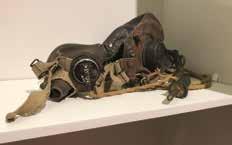
encountered was a Second World War-era breathing mask that pilots used at high altitudes, which she discovered in 15 Wing’s vault. She thought the item was fascinating to touch since it helped her connect with how pilots train today.
A second great experience she had was finding items — like paintings — in the MJMAG’s vault, which brought to life the exhibition.
Being given a major exhibition to co-curate was a fun experience for Tang, who likes working in the arts and culture industry and is always up for new challenges — as evidenced by her moving from Toronto to a new cultural landscape.
“I like how vibrant it is here with the arts scene. I like how friendly and connected (and supportive) the community is and … everyone seems to be really devoted to the arts,” she said. “So I really like it here. I like the fast pace.”

Tang hopes to curate more community-oriented exhibitions in the future and — through vivid storytelling — connect them to historical events or moments. Since she is Chinese, she wants to revamp the MJMAG’s Chinese collection — a project that will happen over the fall and winter.












Alan McLellan’s passion for collecting stamps over the last 60 years eventually led to him collecting facts and stories about Canadian military history, with that information filling dozens of thick three-ring binders.
The retired veteran began his philatelic hobby in 1967 when he was 10 years old, where he focused on aircraft- and space-themed stamps. He continued to collect thousands of similar Canadian seals during the next several decades, building a compilation that fills nearly 50 binders.
“I’m trying to cut down (because) my wife doesn’t want me to fill the house,” he chuckled.
McLellan’s grandfather served with the 46th Battalion during the First World War, so he followed in those footsteps and joined the Canadian Armed Forces as a transport driver for the Royal Canadian Air Force (RCAF) in 1974. However, because of the military’s amalgamation in 1968, which forced everyone to wear the same green uniform, he only received his “air force blues” in 1981.
In the early 1990s, he went overseas to refuel aircraft in Doha, Qatar, during Operation Desert Shield before retiring in 1999 after a 25-year career.
McLellan continued to collect stamps, but around 2004, his focus shifted to acquiring information about Canadian and world military history. Whenever he snagged a military- or war-themed stamp, he researched it and wrote down everything he learned.
For example, he picked up stamps with poppies, so he dug into that symbol’s history and discovered that red represents remembrance, white honours peace and victims of war and purple remembers wartime service animals.

“I’m always thinking big. Maybe I could write a book or something … ,” the retired veteran remarked.
Other interesting stamps that McLellan acquired were from the Second World War and were worth 25 cents. Kids were supposed to collect $4 worth and redeem them for a $5 savings bond. This was to help fund the war effort.
Most stamps that are collectors’ items or valuable are from before the 1940s, but McLellan says he has very few of those. However, he doesn’t necessarily look for the high-value ones but for those that fit with his military-aircraft-space-themed collection.
Meanwhile, McLelland continued to build up his knowledge about Canadian and world mili-

tary history by reading through old newspapers, books and magazines, carefully documenting everything he read.
For example, during the Second World War, he learned that Canadians played pivotal roles during the battles of Dunkirk and Britain, while Saskatchewan played a role in hosting the British Commonwealth Air Training Plan.
These efforts led to him filling 30 binders with all the data, statistics, stories, biographies and information he dug up. From pre-Confederation days to forts to the RCMP to both world wars to Afghanistan, McLellan has covered nearly every topic and era.
“Like I say, I’m a history buff, so I like reading history books. And it’s fascinating to look into things


with a Canadian or Saskatchewan perspective,” he said.
McLellan hopes that someone might be interested in acquiring all the military-themed binders he has filled. He pointed out that history repeats itself — he sees similar patterns between today and what happened decades and centuries ago — and society needs to learn from its mistakes so as never to repeat them.
“I have the honest belief the Americans are going to have a civil war again because of the stupidity that is going on. That’s my own opinion,” he chuckled.
Military career
McLellan served eight years in Europe during his 25-year military career — including a six-month tour of the Golan Heights in Syria — and recalls a “unique experience” he had while stationed in Germany.
The Canadians were on an exercise with the French where they practised bringing wounded soldiers from the front to hospitals in the rear. However, the latter didn’t realize the Canucks were non-conscripted — volunteers, basically — military personnel and never thought that people would choose a military job for a career.
Afterward, the Frenchmen became somewhat jealous of the food the Canadians received.
“Well, they (the French) had rations, but what they’d (receive) for a whole day’s ration would be just enough for a meal for a Canadian,” McLellan chuckled. “One thing the Canadian military … always had (was) good food. … A lot of foreign countries didn’t mind stopping in to see the Canadians for food.”
McLellan added that he enjoyed his military career and encouraged others also to join.




My Grandfather was with the 2nd Pioneer Battalion in WWI. In this picture Canadian Pioneers are placing ‘mats’ near the trenches. Not a great job.


Circumstances of Death
You would think ‘Cook Duty’ would be safe. Not so.
By Richard Dowson
From the WW I “Circumstances of Death Registers Card” for Gunner Charles Donaghy, #92981, 8th Brigade, Canadian Field Artillery, killed November 25, 1917.

The Card reads, “Whilst at a gun position near Kansas Creek in the vicinity of Passchendaele, he was acting in the capacity of Batter Cook in a temporary shelter when he was struck by a splinter from an enemy shell that exploded nearby and died almost immediately.”
Here is another descriptive note from a “Circumstances of Death Registers card” for Private James Donaghy, #775273, 87th Battalion who died November 17, 1917 at Passchendaele.


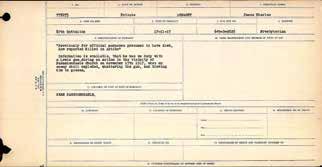

“… he was on duty with a Lewis gun during an action in the vicinity of Passchendaele Church on November 17, 1917 when an enemy shell exploded, shatter the gun and blowing him to pieces.”
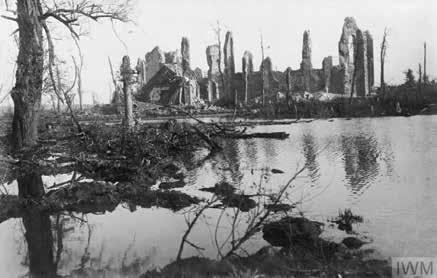




When the federal government authorized the construction of thousands of wartime homes during the Second World War, it thought they would be temporary and would be replaced with better-quality structures.
More than 80 years later, however, due to regular maintenance and care, many such buildings are still standing throughout Canada — including in Moose Jaw — and giving thousands of people a home.
In fact, Moose Javian James (Jim) H. Hunter, an engineering sergeant, was the first Canadian war vet to purchase and own a wartime home under Ottawa’s sell-off plan.
Hunter, who worked for Patterson Motors, which also employed Victoria Cross winner David Currie, purchased 129 Lillooet Street East — across the street from his
Jason G. Antonio
time home in the dominion,” the Times-Herald reported.
To acknowledge these homes’ histories and the people who lived in them, the city’s heritage advisory committee hosted a discussion at the Moose Jaw Public Library recently as part of its efforts to commemorate the 80th anniversary of the end of the Second World War.
The committee’s goal is to build an inventory of the homes for next year — World War II ended in August 1945 — and promote the stories online.
Wartime homes were needed during the Second World War because of government policies from the First World War, including the Soldiers’ Settlement Act in 1919, which offered returning members low-interest loans to purchase land, stock and equipment, explained Janie Fries, the committee’s vice-chair.

mother — in March 1946 and lived there with his wife, Gladys (née Bell), and son Tommy, 5.
“He likes his home very much and is quite satisfied with the deal, which is making him the first veteran owner of a serviceman’s war-
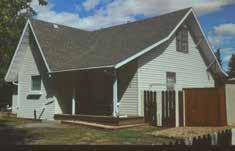

This led to a mini housing boom in Moose Jaw in the 1920s, but after the October 1929 stock market crash and the 1930s’ Great Depression, there was turmoil everywhere that negatively affected families and housing, she continued.
The arrival of the Second World War on Sept. 1, 1939, made the housing situation worse because there was overcrowding and multiple families living together, Fries said. This “doubling up” was difficult because some families had six to 10 children each.
Furthermore, during the war’s early years, there was a lack of supplies and skilled labour because of the Great Depression, while existing stock had deteriorated drastically, she continued. In Moose Jaw, many homes did not have electricity, sewer or water utilities, while few were painted.


“I can remember as a kid, I grew up on Francis Street and there were a few outhouses in the alley,” Fries said.
The federal Liberal government did not want to become involved in constructing homes and wanted the private sector to handle that, but it was dragged into the matter regardless, the vice-chair said.
There was limited wartime housing in 1941 when Ottawa invoked the War Measures Act, but in 1942, the Wartime Prices and Trade Board was established and worked with 29 Canadian communities to establish housing registries listing spare accommodations — like low-quality basements or unfinished attics — and invite applicants to apply.
Furthermore, the Veterans’ Land Act financially assisted vets to help with land and housing purchases.
National Film Board about housing during the war.
The film noted that it took workers 36 hours to erect a wartime home — the walls were prefabricated — and assemble them on serviced lots, homes were built in batches of 200, 500 and 1,000, and there were four external styles with 12 internal designs — a Moose Jaw-born, Toronto-based architect developed the designs.
While the homes met families’ needs, the structures had no basements, so some homeowners built 10-foot by 10-foot back porches or modified attics for storage.
“… These (homes) were to be temporary, and after the war, they were to be removed and more substantial houses built. Well, with good maintenance, we’ve seen a number of them (that) have withstood the test of time,” Fries said, noting people criticized Ottawa for selling off the homes because few had money for down payments.
While some communities had entire neighbourhoods of wartime homes, Moose Jaw’s were constructed on infill sites, she added. While her team counted 366 wartime homes — she initially thought there were 150 — they believe there are more.

Ottawa established the home conversion plan in 1943 to lease, convert and sublet available buildings, and in 1946 and ’47, the three housing-focused organizations combined to form the Central Mortgage and Housing Corporation (CMHC).
Fries showed a video from the

Jessica McNaughton, co-founder and CEO of memoryKPR, an online program similar to a time capsule, then spoke about how her company is helping the committee save the history of these homes and their former owners.
Thousands of patriotic residents crowded Moose Jaw’s train station, hoping for one last look at the soldiers departing for the training grounds of Quebec and — eventually — the battlefields of Europe.
The enthusiastic send-off that residents gave the men on that Sunday, Aug. 23, 1914, hadn’t been seen since 1899 when Great Britain had asked Canada for support to fight in the Second Boer War in South Africa.
Now, 15 years later, after war had broken out in Europe on Aug. 4, 1914 — 110 years ago — the Motherland was calling again, and Canadians were responding by the thousands.
In Moose Jaw, residents — allegedly the entire community — turned out to see the volunteers of the 60th Rifles and 27th Light Horse board the special train to Valcartier, Que., for training, and from there, by ship across the Atlantic.
The 60th was comprised of men from Moose Jaw, while the 27th was filled with men from rural communities.
“There was no feeling of loyalty lacking, but it almost seemed as though the great crowd, brought face to face with the grim reality of war, hesitated to part with the flower of the country’s manhood … ,” the Moose Jaw Evening Times reported on Monday, Aug. 24.
“Strong men and brave women felt the burning of tears in their eyes as they clasped the hand of brother, father, husband, friend or sweetheart, and the sudden awful thought came that perhaps it might be the last hand claps and the last goodbye,” the article continued.
The troops boarded the train, and as the engine bell began ringing and a deafening outburst of cheers arose, the engine headed east. There were many prayers on the lips of those who lined the platform, hoping for the safe return of their loved ones.
Time to leave
Jason G. Antonio

the old flag stood for today.”
The men of the 60th Rifles and 27th Light Horse had been waiting nearly two weeks to depart for Valcartier when they finally received notice that the time had come.
So, on that Sunday morning, 225 members of the 60th formed up at the armouries, where thousands of people began gathering around 9:30 a.m. By 12:30 p.m., with the 60th Rifles’ band leading the way, the troops marched down Main Street to the train station.
“As the first of the men entered the station yard, the crowd, pressed back by the local police and fire department, swarmed onto the special train and into the cars and onto the roofs of the cars … ,” the Evening Times reported.
“Cheer upon cheer rose from the immense crowd. For upwards of half an hour, the men were kept waiting on the station platform,” the article continued, “but finally the order was given to entrain, and then the police were unable to hold back the crowd any longer and men, women and children broke through the ranks to say last goodbyes.”
Around 3 p.m., a similar scene repeated itself as 25 soldiers with the 27th Light Horse marched to the station and boarded the train, which bore 190 red-coated men who had enlisted from west and

southwest Saskatchewan.
The mayor extended godspeed to the officers and men and gave a $150 donation to the commanding officer, Col. Tuxford, to support the men at Valcartier.
Meanwhile, the colonel told the crowd that he had some of the finest men under his command, and if they reached the front line, the crowd would hear nothing but good things about them, while “if they had to die, it would be facing the guns and as heroes.”
Tuxford’s patriotic enthusiasm “enflamed the crowd,” while every effort he made to speak thereafter led to great bursts of cheering that lasted for 30 minutes. By then, the signal came, and the train left the station, with hundreds of people lining the tracks on both sides as far east as the 11th Avenue subway.

Pascoe added that residents’ prayers would “be mingled with your own for your preservation.”
John Crawford, the vice-president of the board of trade, said it was a “great pity that the very best blood of their manhood” had to leave their peaceful occupations and fight “in that unholy war, which had been forced on civilized humanity.” However, everyone was proud that the men were willing to fight in the interests of “higher civilization.”
Crawford promised that, on behalf of Moose Jaw’s mercantile men, the soldiers’ dependents would be supported.
Maj. J.D. Simpson, the 27th Light Horse’s commanding officer, explained that he wasn’t joining his men because “the persuasive powers of his wife had prevailed.” However, he said the biggest hope was that the war would be short and the contingent would return soon and be “crowned with glory for the deeds of valour they had accomplished.”
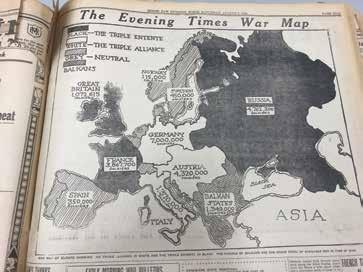
A fitting send-off
The community held a civic send-off ceremony at the armouries on Saturday, Aug. 22, the night before the men departed, with nearly 2,000 people packing the venue to hear five speeches, “all breathing with patriotic fervour and urging the men on to do their duty.”
“We expect you to do your duty,” Mayor Pascoe said, “and we are sure you will do it, for we all have confidence in the boys from Moose Jaw.”
His Worship pointed out that the men must prove that “the old fighting spirit of the Anglo-Saxon was just as prominent, while the blood course through their veins, was just as rich as in the days of their forefathers who fought and died for the principles for which
“I wish you all godspeed and a safe return,” he concluded. “I only hope that I will be able to meet you here again without a single exception.”
Rev. W.G. Wilson, on behalf of the community’s ministerial association, said the men had high-calibre characters, and he hoped they upheld the honour of the city and province. He also hoped they never lost their identity of being connected with Saskatchewan.
Wilson pointed out that Jesus Christ, the Prince of Peace, said peace sometimes had to be established with the sword. So, he hoped the men’s contributions brought the war to a speedy end with a lasting peace through their unselfish volunteerism and readiness to bear arms for King and country.
The priest jokingly added that he was sorry to see some men leave who were good candidates for the priesthood.

Military Police officer Jim Alexander served in various countries during his 34-year career, but Afghanistan may have been the most memorable because of the heat and the wonderful aroma of “poo ponds.”
Alexander, 58, was in the West Asian country in the late 2000s, helping guard Canadian bases, the personnel working there and any famous people — like country singer George Canyon — who visited.
A military policeman (MP) is similar to a municipal police officer, except he guards higher-level venues such as military installations or embassies.
One thing that has stuck with Alexander from his time in Afghanistan was the weather and how it affected his body.
“There was a dry heat. It was good, but the temperature would drop massively between day and night,” he said. “So, the weather was good. It was good on the body … (because there was) no pain in the knees, neck or hips. (It was also) hot every day (and) sweaty.”
One humorous memory Alexander has from Afghanistan is the “poo ponds” — open aeration sewage venues — that he encountered during his travels.
“Whenever somebody would come in, we would take them for

Jason G. Antonio
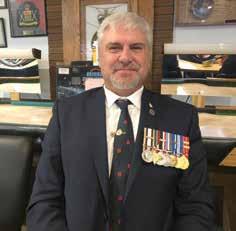
lunch and then take them around the poo pond … (to) get them to get the aroma of Afghanistan, you could say,” he chuckled. “So I think a lot of (MPs) did that to show (guests) what it was about.”
Another satisfying memory
Alexander has is the work that Canada and its allies performed that helped transform the country, from which the Afghanis benefitted.
“I worked (security) in the markets in Afghanistan just to see the locals and the success of their businesses while we were there to keep the economy going and keep them employed,” he said.
With a chuckle, Alexander added that he was unable to pick up any of the country’s languages since he’s no good at that and can barely
speak “Frenglish — I mean English.”
Alexander joined the military in 1983 at age 17 because his father and grandfather had both served, so he felt called to serve his family and his country. He initially joined the 13th Field Battery, 26th Field Regiment, in Portage la Prairie, Man., before he joined the regular force and transferred to the Prince Patricia’s Canadian Light Infantry (PPCLI) in Calgary.
Interestingly, his son also joined the military and was posted to Cold Lake, Alta. — 20 years after Alexander was posted there, whose own father had served there 30 years before. In total, the Alexander family has contributed 125 years of military service.
In 1983, at age 18, Alexander was posted to Wainwright, Alta., where, during one special regimental day, he engaged in a snowball fight with others and received a cut under his right eye.
He was receiving stitches in the infirmary when the duty sergeant walked in and said his mother was on the phone and wanted to speak — yell! — with him. The officer knew his father, so he called Mrs. Alexander to report the injury.
“Everybody knew everybody … . It was terrible,” Alexander chuckled.
In 1991, because of an injury, he re-mustered and became an MP,





an operational unit with which he served — in other places like the Middle East and Balkans — until retiring in 2017 after 34 years.
“I’d do it (serve) again. Within a heartbeat, I would do it again if I had the opportunity (because of the) sense of service,” he said.
Alexander finished his career at 15 Wing Air Base, saying that his career was fulfilling, he felt like he accomplished things, and he had no regrets.
“You do a lot of things that a lot of normal people wouldn’t do. And every day was a different day … ,” he added. “No matter what the task was, it was done (and) it was completed.”






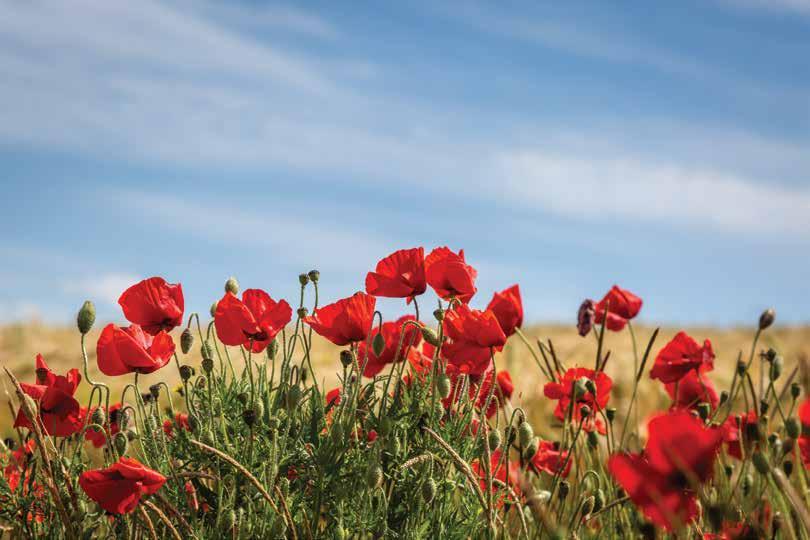

The Juno Beach Centre (JBC) in France is encouraging students to apply to be a guide for the 2025 season, which marks the 80th anniversary of the end of the Second World War.
This is a special opportunity for bilingual students — either taking post-secondary education or who graduated within the last three years — to engage with visitors from around the world and share the rich history of Canada’s contributions during that war, the JBC said.
The guide program was born of the wishes of the veterans who founded the Juno Beach Centre over 20 years ago. These men wished for a group of dynamic and motivated Canadians who are roughly the same age as they were in 1944 to participate in the museum’s educational and cultural missions.
Successful candidates will lead guided tours of the outdoor park, including historical bunkers and Juno Beach, adapting their presentations to diverse audiences such as school groups, veterans, and dignitaries. They will grow in their knowledge of Canada in the Second World War and be a part of carrying the torch of remem-

By Moose Jaw Express staff

brance.
Applications for the May 22 to Dec. 31, 2025, work term are due by Monday, Nov. 11, 2024. Interested students are encouraged to prepare their applications early, showcasing their bilingual capabilities and their passion for history, public speaking and customer engagement.
“Every visitor who comes in has a story to tell and a private reason for coming to see the site. It was heartwarming every time someone wanted to share it with you, but (it) could (also) be difficult at times

given the intimate subject,” said Madison Dundas, a 2024 student guide from Toronto.
“It is impossible for me to accurately describe the profound gratitude I feel for my time spent among the exceptional team at the Juno Beach Centre,” said Camille Charbonneau from Gatineau, Que.
“When I was 15, I had the chance to visit the Centre with my family. I had always promised myself that when I finished my university studies, I would apply to work with your organization,” she continued.



“When I submitted my application, I never imagined I would experience so many memorable moments that, I can say with certainty, allowed me to grow in my personal and professional life.”
The Juno Beach Centre — located in Courseulles-sur-Mer, France — was established in 2003 as a permanent memorial to all Canadians who were part of the Allied victory in the Second World War and to preserve this legacy for future generations through education.
The centre in Normandy, France, pays homage to the nearly 45,000 Canadians who died during the war, including 5,500 during the Battle of Normandy and 381 on D-Day alone.
Twenty years and more than 1.3 million visitors later, the centre has been designated a site of national historic significance to Canada. It is owned and operated by the Juno Beach Centre Association, a registered charitable organization based in Burlington, Ont.
To learn more, visit www.junobeach.org.
For more information about the guide positions and the application process, visit www.junobeach. org/student-guide-program.
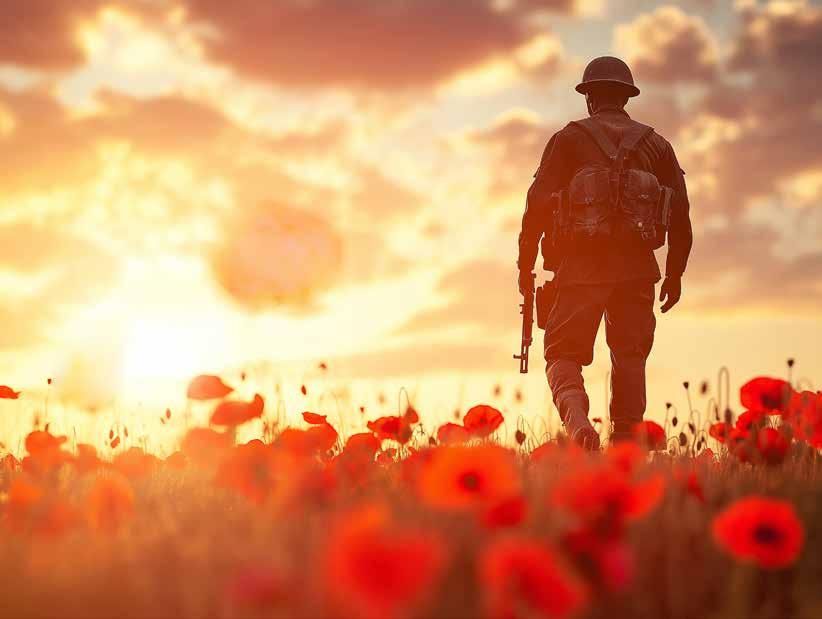

Jeff Albert Nicklin was born December 10, 1914, and raised in Winnipeg.
His father Percy Nicklin was a successful hockey player and coach, coaching the Moncton Hawks to two successive Allan Cup victories. They beat the Saskatoon Quakers in 1933 and the “Fort William Thundering Herd” in 1934.
Hockey ran in the Nicklin family. Jeff was good in all sports but chose football.
Jeff played all his ‘school’ football in Winnipeg and joined the Winnipeg Blue Bombers in 1934 at age 19. He began playing defensive end. In 1937 he was a West All-star as an end.



By Richard Dowson
Nicklin moved to “Flying Wing”, today called Receiver and/ or Running Back. He was an all star in that position in 1938 and 1939 and played for the Bombers for seven seasons.
His football career is hauntingly like current Blue Bomber Running Back Brady Oliveira, both Winnipeg boys.
World War Two
Jeff joined the Winnipeg Rifles in 1940 as a Private. In September 1942 he transferred from the Rifles to the 1st Canadian Parachute Battalion. He trained in England, Fort Benning Georgia and Shilo, Manitoba. After his training he became an instructor. Natural leadership qualities led to Nicklin being sent for officer training.
He jumped into Normandy with his Unit on the night of June 5/6, 1944. He had success with his group until July 1944 when he was severely wounded when one of their own mines was triggered. He spent weeks in an English hospital recuperating.
He rose though the ranks and on September 8, 1944 he was promoted to Lieutenant Colonel and

took command of the Battalion. He was just 29 years-old.
Another Allied ‘Bold Plan’ called Operation Varsity was set for March 24, 1945. Paratroopers would drop into Germany near Wesel. It included the British 6th Airborne Division, that included the Canadians, and the U.S. 17th Airborne Division. It would be a largest airborne drop of the war.
Lt. Col. Jeff Albert Nicklin was killed in action on March 24, 1945 during Operation Varsity. His parachute caught in a tree. He was defenseless. German ground forces and snipers shot him many times.


The Jeff Nicklin Memorial Trophy
In 1946, in honour of their Commanding Officer Jeff Nicklin, the1st Canadian Parachute Battalion presented to the Canadian Football League, Western Division, with the “Jeff Nicklin Memorial Trophy”. It was to be presented to the Most Outstanding Player in the Western Division.
In 1968 and 1969 the winner was George Reed of the Saskatchewan Rough Riders.
The Irony
The 2023 Winner of the Jeff Nicklin Memorial Trophy was Running Back and Receiver, Brady Olivares of the Winnipeg Blue Bombers Another Winnipeg Kid








The Saskatchewan Veteran Service Club Support Program has been fully subscribed for 2024-25 in a single intake, providing grants up to $30,000 to 81 veterans’ organizations throughout the province.
“The Government of Saskatchewan is proud to invest $1.5 million annually to support Legion branches, Army, Navy and Air Force Veterans units and other registered non-profit organizations that support our Saskatchewan veterans in the province,” Parks, Culture and Sport Minister Laura Ross said. “Veterans service clubs are so important, they enrich our communities, preserve local history and work tirelessly on behalf of veterans who have faithfully served our province and our country. We thank them for their continued efforts and look forward to continuing this work.”
Introduced in 2019-20, the program provides grants for repairs and upgrades, special events, operations, programs and activities to engage communities and advance the work and long-term sustainability of veterans’ service organi-
zations across the province.
The program is delivered collabo ratively by the Royal Canadian Legion, Saskatch ewan Com mand, the Sas katch ewan Army, Navy and Air Force Veterans (ANAV ETS) and the Government of Saskatchewan.

“Thank you to the Government of Saskatchewan, the Ministry of Parks, Culture and Sport and the Honourable Laura Ross for their leadership in recognizing the value of veterans and the good work of the Royal Canadian Legion”, Royal Canadian Legion Saskatchewan Command Provincial President
Carol Pedersen said. “The financial and moral support helps us to meet and achieve our challenging goals and to carry out our mission of assisting veterans in our communities and in promoting remembrance. The Veterans Service Club Grant allows branches to do necessary updates and improve their facilities.”
Since the program’s inception, nearly $6.0 million has been allocated to 393 successful applicants in more than 115 different communities across the province.
“The Saskatchewan ANAVETS are very happy to be a part of
the Veterans Service Club Support Program,” ANAVETS President Rick Taylor said. “We have benefited immensely. Each of our units have received new furnishings/appliances, upgrades to our buildings which include flooring, roofing, plumbing and heating. Thanks to the Legion for facilitating the program and as well to the Saskatchewan Government for funding it. The veterans, their families and friends appreciate what has been accomplished and will enjoy these enhancements for years.”
In 2023-24, a total of 77 grants were awarded to clubs across Saskatchewan. Typically, at least two application intake periods were required each year. With increased awareness of the funding that is available, the program has been fully subscribed for 2024-25 through the first round. More information about the program, guidelines, applications and eligibility are available through the Royal Canadian Legion Saskatchewan Command at 306-525-8739 or admin@sasklegion.ca.



Moose Jaw’s F/O Robert Alexander Urquhart, J/9763, Navigator with 617 Squadron, RAF was killed on the night of May 16/17, 1943 on the return leg of the Dam-Buster, bouncingbomb Raid on German dams.
The Bmber had been damaged as their low flying Lancaster ED937, AJ*Z, struck a power line. The entire crew were killed.
My good friend and fellow historian, Simon Muggleton, East Sussex, England, attended the special memorial for the crew of AJ*Z. He has written this wonderful description of the event, held in the field near Emmerich, Germany where they crashed.

British Historian, Simon Muggleton Celebrates the Memory of Moose Jaw’s DamBuster, R.C.A.F. Flying Officer Robert ‘Turk’ Urquhart DFC
‘Turk’, a RCAF Navigator, was killed on May 17, 1943. Simon represented Robert’s absent family and, unofficially, the City of Moose Jaw, Saskatchewan at the special memorial service. These are the words of Simon Muggleton, Sussex, UK Postscript to Robert Urquhart DFC
After writing a short article on this Canadian ‘Dambuster’ in 2013 for inclusion into the publication, RAF Souvenir 70th Anniversary Dambuster Edition, and having had contact with the five surviving airmen who actually flew on the raid, I thought all my goals had been reached regarding research into this airman.
Then out of the blue, in early 2019 I received an e mail from a German and British aviation historians, Marcel Hahn, and Mark
Introduction by Richard Dowson
Welsh informing me that they had located the crash site of Lancaster ED 937 AJ-Z, in a field in Emmerich, also recovering pieces of the actual aircraft. Not only that, but they had also managed to fund raise for a memorial to be erected adjacent to the crash site in Emmerich, which would be dedicated on Friday 17th May 2019, and would I attend!
Without hesitation I accepted, and booked the ferry the same day, an opportunity too good to miss.
On our arrival the day before, my wife and I met with the two historians, who informed us that relatives of the pilot of AJ-Z, Squadron Leader Henry Maudslay DFC, and the Flight Engineer, Sergeant John Marriott DFM, were also attending. The biggest surprise came when they announced that at the ceremony the then 16-year-old flak gun-layer, Johannes Doerwald, (who was credited with shooting down Lancaster ED 937) would also be in attendance and making a speech.
On the day, Herr Peter Hinze the Burgomeister of Emmerich gave a short speech in both English and German welcoming all those who had attended, including the British relatives and representatives of six NATO nations, along with local residents.
The RAF was represented by Wing Commander Paul Withers from the NATO Combined Air Operations Centre in Uedem, who gave a short speech part of which stated; “This post war reconciliation has led to strong bonds of friendship between former enemies, aided by a strong NATO alliance. That this memorial stone has been created is evidence of the strength of those bonds in friendship, and it is a fantastic tribute to the crew of AJ-Z, and the efforts of Marcel and Mark.”
This was followed by Johannes Doerwald giving a very moving speech: “I still remember well the moonlit night of 16/17th May 1943, when the catastrophe at the dams happened. A four engined bomber flew past us at low altitude towards the Mohnesse. I cannot forget the sight of this colossus. When the gunner released ‘fire’ I was so excited that I had forgotten to put the safety lever around. The machine flew so low



that it collided 20km from here with a high voltage line.
“Then on the return flight came Lancaster ED 937. I still recall today how it was hit by our tracer ammunition.
(Special Note: It was on Maudslay’s third run at 0145 hrs into the Eder Dam that Gibson noticed something hanging down below AJ-Z (caused by flak between the Scheldt and the Rhine, which may have also damaged the bomb release mechanism, causing the Bomb Aimer, P/O Mike Fuller to release the ‘Upkeep’ too late, which then hit the dam parapet, causing further damage to the tail of the Lancaster). It was this damage that made them a ‘lame duck’ which was spotted by the flak crew over Emmerich and downed the aircraft.)
“That night, 53 young people, who still had their lives ahead of them, died. Such a cruel war must not be repeated”.
Following the speeches Marcel and Mark paid tribute to the individual crew members of the Lancaster, before a minute’s silence was observed and the memorial stone unveiled.
I planted a British Legion wooden cross with Urquhart’s name on, next to the other wreaths by the memorial.
During my research into this Canadian Dambuster I have had tremendous help from another aviation historian in Canada, Richard Dowson, who actually lives in Robert Urquhart’s home town of Moose Jaw, Saskatchewan, and has written for the local paper about Urquhart and the memorial in Germany.






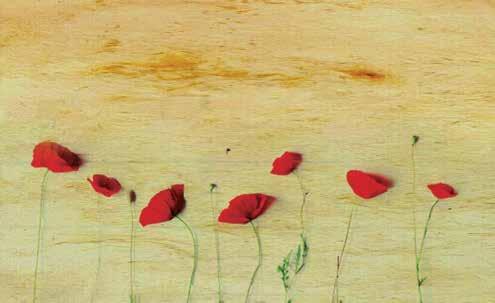
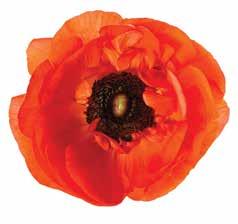



Twenty-three banners featuring Moose Jaw veterans now hang from light poles on Main Street as part of a project that city hall pursued to honour those who served in war and peace.
Below are the biographies of three brothers who appear on the banners. The information comes from the City of Moose Jaw website.
This is part 7 of 7.
Arthur George Wilson
Our father, Arthur George Wilson, was born to William and Annie (Sherris) Wilson on Nov. 8, 1923. He was raised on the BW Bar ranch southeast of Coderre, Sask. with four sisters and three brothers.
George was only 17 when he and his two brothers joined the war effort on June 19, 1941. They were sent to Portage la Prairie, Man., and then on to Camp Borden, Ont., for basic training. George and Dave became part of the 9th Armored Regiment of the B.C. Dragoons. Their younger brother, Mac, served with the North Strathcona Lighthorse Tank Corps.

By early November 1941, the Dragoons were boarding the H.M.T. Andes at Pier 21 in Halifax, N.S. A convoy of USA warships escorted them and other troop ships. About mid-ocean, they were met by British naval vessels that took over, delivering them safely into Liverpool, England on Nov. 22.
It was at Marlborough, Wiltshire and Aldershot, Hampshire, where training with tanks, signalling and weapons was carried out. Whenever he was on leave, George would head into a city or up to Wishaw, Scotland, to visit his paternal grandfather and family.
After nearly two years in England, the time came to board the Samaria travelling to Naples, Italy. From there, the regiment fought its way through to France and later the Netherlands. During his years at the front, George was wounded once, thankfully not seriously.
V-E Day on May 8, 1945, brought relief that the war in Europe was over. The B.C. Dragoons joined other Canadian units in moving approximately 140,000 German prisoners of war from
Jason G. Antonio
the Western Netherlands to Germany.
All three brothers returned home with the Five-Year Medal and Clasp, the Defence Medal, the Canadian Volunteer Service Medal, the Italy Star, the France & Germany Star and the 19391945 Star. After being discharged on Dec. 7, 1945, George returned to ranching, taking over the family homestead.
He knew a lot about horses. Often, he would be called to stock sales to help identify a colt. With one look, he could tell who its sire and dame were just by its features. He also settled many disputes.
On Feb. 12, 1948, George married Fernande Marie Gaucher, daughter of Rosalphe and Bertha (Arguin) Gaucher. They had three children, living first on the ranch and later in Coderre. George was an active member of the Royal Canadian Legion, Coderre Branch No. 22 and one of the founding members of the Coderre Lions Club.
After a battle with cancer, George died on May 10, 1979.
Malcolm (Mac) Wilson
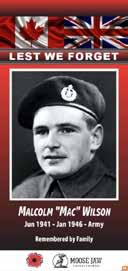
Malcolm (Mac) Douglas Wilson was born at the BW Bar Ranch, six miles southeast of Coderre, Sask. Mac, along with brothers David and George, joined the army in June 1941. He trained with the Lord Strathcona Horse Corps in Regina, Portage La Prairie and Borden and could fill any position in a Sherman tank.
On Dec. 8, 1941, he sailed for England on the Pasteur. Two days later, Mac celebrated his 17th birthday at sea, drinking stale, flat draft beer out of an aluminum mess tin. What a celebration! After further training in England, he headed to Europe to fight in the Italian Campaign.
After 18 months of battle, four Christmases, four birthdays and two wounds, he said goodbye to Italy on Feb. 18, 1945. Landing in France, he fought through Belgium and then to Holland. As part of the Canadian humanitarian effort, Mac came to the aid of many, including a young Dutch family.
In May 1995, Gerdine Koopmans, the daughter of a family Malcolm helped, located him through his nickname “Lucky” in




an ad in the Legion magazine. After 50 years, she finally located him to thank him, and they met in August 1995. Gerdine attended Mac’s 90th birthday party.
May 8, 1945, was VE Day and Mac stayed behind to transport civilians back to their homes and to escort German soldiers out of Holland. On Jan. 19, 1946, he returned home to his family. He was two months into his 21st birthday.
Mac married Lil and they had five children. Both maintained a lifelong association with the Legion. Mac was awarded the Palm Leaf to the Meritorious Service Medal in recognition of his long and exemplary service to the Legion.
Mac died on Sept. 30, 2015, two and a half months shy of his 91st birthday.
David Guy Wilson
Trooper David Guy Wilson was born on July 25, 1922, and raised southeast of Coderre, Sask. on the B.W. Ranch along with his three brothers and four sisters.
On June 19, 1941, David and his two younger brothers, Malcolm Douglas and Arthur George, went to Regina to enlist to fight in the Second World War. They were sent to Portage la Prairie and then to Camp Borden for basic training.
Dave and brother George were assigned to the 9th Armoured Regiment of the B.C. Dragoons, while Mac was assigned to the Strathcona Light Tank Corps. Leaving from Pier 21 in Halifax, they arrived in Liverpool on Nov. 11, 1941. Dave soon found himself in battles in France, Germany, Italy, Holland, Belgium, and the central Mediterranean. On Dec. 7, 1945, Dave was discharged and returned home.
On Oct. 24, 1947, Dave married Therese Lepine, and they lived on the half-section farm Dave had acquired from the VLA — until their house burned down. They then moved into Coderre, where Dave farmed from town and Therese ran the telephone exchange.
On June 28, 1969, Dave died, leaving behind Therese and four children.






by Jason G. Antonio


Flying Officer Clarence Gordon Gavan was participating in a training exercise over the skies of northeast England on Nov. 6, 1944, when he lost control of his Spitfire aircraft and crashed into the woods below.
The Moose Jaw-born pilot, 28, had just completed a machinegun activity with another Spitfire when the two began chasing each other before making a dummy

attack on a passing Lancaster bomber. However, Gavan was unable to pull out of his dive and crashed southwest of Grimsby, Lincolnshire, England.
Gavan was the son of John Michael and Belle of Moose Jaw.
Warrant Officer II Howard Eldon Bradley, 23, with the Royal Canadian Air Force, had been attached to the Royal Australian Air Force as a wireless air gunner on a Wellington bomber flying out of Africa.
The plane was on an armed reconnaissance patrol near Sardinia, Italy, on July 13, 1943, when the crew had contact with the enemy at 11:20 p.m. The air base lost contact with the bomber, while it failed to return from its search of the sea around the Italian island. It was presumed that a night fighter or anti-aircraft fire shot down the aircraft.
Bradley was born on Dec. 1, 1919, in Weyburn, to William and May Bradley and was the brother to sisters Eileen and Maureen and brothers Lindsay and Creighton. He moved to Moose Jaw in 1932, where he attended school and joined the Canadian Pacific Express.
He enlisted on July 28, 1941, in Brandon, Man., and graduated as a wireless operator and bomber


in March 1942, while he arrived in England a few months later.
Bradley’s body was never found, so his name was etched into the Malta Memorial, along with 2,293 other men whose bodies were never recovered.
Flight Lt. Harry Curd Bennett, 27, was a Spitfire fighter pilot with 406 Lynx Squadron and was training in England on Aug. 13, 1943, when he collided with a Wellington bomber. Bennett’s plane lost its wing and spun into the ground near Suffolk, England; everyone on both planes died.
Bennett was the son of George and Annie Bennett of Moose Jaw and the husband of Jeanne Olivia (née Wimbles) of Vancouver, British Columbia. He is buried at Beck Row (St. John) Cemetery in Suffolk, U.K.
Flight Sgt. Arie Gordon Baxter, 21, was a mid-gunner on

Lancaster bomber No. 768, which was flying toward Soest, Germany on the evening of Dec. 5-6, 1944, when it collided with another aircraft of 428 Ghost Squadron and crashed, killing everyone on board.
Baxter was the son of Gordon and Ella Baxter of Moose Jaw. He was buried in Brookwood Military Cemetery in Surrey, U.K., about 48 kilometres away from London.
Flight Sgt. William Henry Cook, 26, was an air gunner on a

Lancaster bomber with the Royal Air Force’s 550 Squadron and was on a mission to bomb the Prosper Benzol Plant at Bottrop, Germany on Feb. 3, 1945.
However, during the flight, a German night fighter shot down the aircraft, which crashed at Nieuweweg road, Westerbeek, Noord-Brabant, Holland. The plane was initially reported missing before authorities confirmed that it had crashed and everyone on board was dead.
Cook was the son of Ernest and Mary Louisa Cook, who lived at 1037 Clifton Avenue, and the brother of Ron. He attended Ross and King Edward schools and Central Collegiate. He had been a member of the air cadets and went overseas in 1944.
Cook was buried in the Oploo (Westerbeek) Roman Catholic Cemetery in the Netherlands.








































Veteran Sherri Wedel served as a military police (MP) officer for 31 years, with one of her most endearing memories being the fundraisers she participated in to support refugees and others in need.
She worked with other MPs on a project called the Blind Fund, which collected money for children with eye troubles. No matter where she was posted — from Cold Lake, Alta., to Baden, Germany — they usually collected plenty of money for the cause.
Their normal practice was to take juice cans, cut them in half, wrap paper around them and write in English, French German and Turkish why the cans were out.
“Within a week, they would fill. So we would raise … $40,000 for the Blind Fund. It was fun,” Wedel

said. “It’s a huge, huge fundraiser that the military police have done … since the ’50s.”
The MPs always attempted to give back wherever they were stationed while they engaged in positive community activities such as bicycle rallies, bike-a-thons or rodeos with kids.
Wedel recalled working at a Royal Canadian Air Force base in Borden, Ont., where hundreds of Kosovo refugees had been housed.

Jason G.

With so many kids on base, Wedel and other MPs bought them bikes.
“Everybody chipped in (and) everybody did everything they could. You’re always trying to give back to the community,” she added.
Born in Vancouver, British Columbia, Wedel was 22 when she enlisted in the regular forces in 1983 after spending the previous four years as a Sea Cadets’ officer. However, her father didn’t approve of her joining the military, nor even joining cadets.
“But I did it anyway and he’s proud of what I’ve done,” she said.
Wedel always wanted to be a police officer, whether it was with the RCMP, military or Vancouver city police service. However, the military called first, so she jumped at the opportunity and became an MP.
Wedel’s older brother Victor was in the military when she joined, but he never learned about her decision because he died in a training accident in Baden, Germany, the year she enlisted. She noted that Victor was preparing to throw a grenade during the exercise when he pulled the pin and the device exploded immediately, killing him and another man.
“I had already joined, so that (death) didn’t influence me. But my brother and I were tight anyway,” she reflected.
The Canadian Armed Forces began allowing women to join in the early 1970s — full integration occurred in 1989 — while the military police began accepting women in 1974.
When Wedel joined in the early 1980s and was sent to Cold Lake, she was fortunate since there were 10 women on base, which was un-


heard of for one unit since it would normally be two to three females.
“But at first, you had to prove yourself,” she recalled.
Wedel remembered having to clean everything while ensuring coffee was made for new shifts — essentially, she was “being treated like a maid.” So, she met with the sergeant and told him she didn’t join the military for that work while she was just as capable as the men.
After that, her situation changed for the better. However, she pointed out that not every woman was capable of being an MP, so some had to prove themselves continually.
Wedel served in Germany from 1989 to 1993, which she said was a fantastic post since she worked with the French and German forces. The MPs were forced to work extra hard around 1990 because the Gulf War was underway and the base was receiving regular threats of attack.
The veteran also operated as a criminal investigator and worked with Germany’s criminal police section and France’s gendarmerie on “some really good investigations,” such as missing children cases.
“So it was fantastic. And when we closed the bases (Baden and Lahr) down, it was the saddest thing we ever had to do,” she added.
Over the years, as an MP, Wedel protected many important dignitaries, from the pope to governors general to Prince Charles to the Queen Mum to prime ministers to musicians like Brian Adams. She noted that, contrary to rumours, the prince was “a very nice man,” while she snapped a “beautiful photo” of the Queen Mum in a green dress.
Wedel retired in 2014 and moved to Moose Jaw, where she made friends with a group of other retired MPs.





Canadian Females have been flying airplanes for almost 100 years. The first Canadian female pilot was Eileen Vollick, born in August 1908. Eileen ‘wing-walked’ on a Curtis JN-4 and, as a special demonstration, parachuted into Burlington Bay at age 18. When Pilot training was opened for nineteen-year-olds Eileen signed up. She took flying lessons in Hamilton, Ontario and graduated with her ‘wings’ in March 1928. Eileen received Private Pilot Certificate #77.
Many more females qualified as pilots.
RCAF and WWII
The War started in September 1939 and the RCAF began expanding. Qualified female pilots applied to the RCAF but were not accepted. This poster explains the attitude. Men were to do the flying.
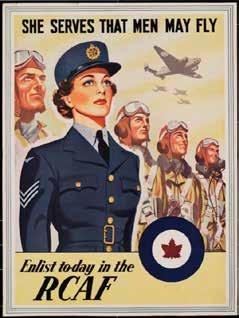
The Alternative – Air Transport Auxiliary (ATA) – Open to Female Pilots
Qualified female pilots were accepted in the Air Transport Auxiliary. The ATA also accepted qualified pilots too old to join the RCAF; considered medically unfit by the military because of missing limbs or vision problems and ‘Minorities’ not yet accepted in the RCAF as Pilots.
The Air Transport Auxiliary
By Richard Dowson

yet open, so she went to work in administration at the Dental Unit in Winnipeg.
Pilot training finally opened. “In 1979, Captain Deanna Brasseur, Captain Leah Mosher and Captain Nora Bottomley were the first women selected for pilot training in the CAF.” (RCAF)
Dee was presented with her Wings on February 13, 1981.
Is There a Moose Jaw Connection? There’s always a Moose Jaw connection!
After getting her Wings Dee was posted to 2CFFTS (2 Canadian Forces Flying Training School) Moose Jaw where she taught for four years.
Flying Fighters
Who doesn’t want to fly a Fighter?
Having civilian ATA pilots fly non-combat military aircraft allowed military aircrews to continue to fly military operations.
Air Transport Auxiliary Pilots were expected to fly all types of military aircraft, from single engine to multi-engine. From Spitfires to Wellingtons and Mosquitos.
ATA eventually had 1,152 male and 168 female pilots. The Pilots were in ‘Pools’, working 12 days on and 2 days off. The ATA female pilots were called “ATTAgirls”.
Canadian Female ATA Pilots: Violent (Vi) Milstead and Marion Alice Orr
Several Canadian Female Pilots applied. Some made it, others washed out in training. Two notable Canadian ATA pilots and life-long friends were Violent Milstead and Marion Alice Orr. They flew every type of aircraft available – without any special training. If they had to deliver a Hawker Typhoon from here to there – they checked a manual and took off.
First Officer Vi Milstead, #W111, served from April 5, 1943, to July 31, 1945. Second Officer Marion Orr, #W112, served from April 5, 1943, to October 1944.
The ATA, formed in the fall of 1939 with headquarters in Berkshire, England, was a civilian organization associated with the Royal Air Force. The ATA ‘moved airplanes.’ Some were flown from North American factories to the UK, others, to and from maintenance facilities and some from one active squadron to another active squadron.
Five foot two Vi flew many types of aircraft, from single engine fighters
to multi-engine bombers like the B-25 Mitchell. The most challenging was the Hawker Tempest. Vi’s favorite was the De Havilland Mosquito.
After the war the Air Transport Auxiliary was disbanded. Vi and
In June 1988 Dee Brasseur and Jane Foster were accepted into the Fighter Pilot training program. They qualified on the CF-5 and the CF-18 in June 1989.
Today all branches, including combat, are open to females.

Marion and others, including Helen Harrison-Bristol, continued their careers in Aviation.
The RCAF and Female Pilots
The RCAF was slow to change but eventually accepted female pilots.
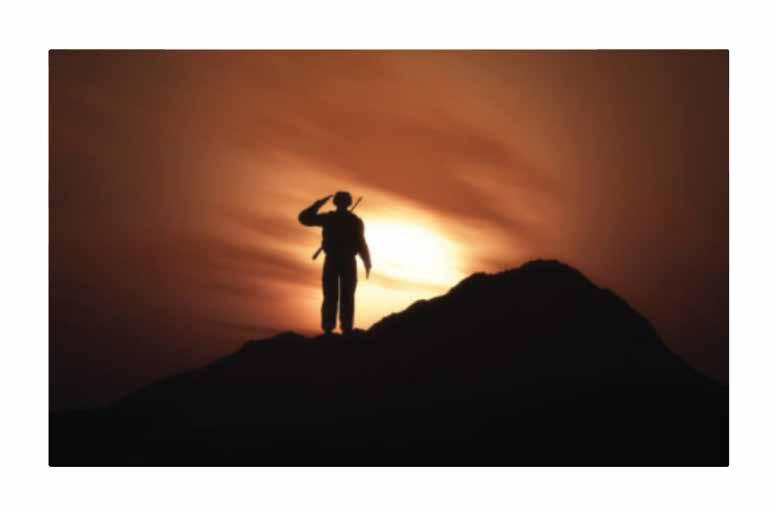
In 1972, nineteen-year-old Dee Brasseur joined the RCAF. She wanted to be a pilot but that option was not

















A statue that will be placed in France to commemorate the landing of the Royal Regina Rifles on June Beach made its way to the grounds of the Legislature recently.
The statue was displayed at a special public ceremony at the Saskatchewan War Memorial on April 6. The ceremony was attended by military personnel and local and provincial dignitaries, including Lt.-Gov. Russ Mirasty. A flyover from two Royal Canadian Air Force CT 155 Harvard II aircraft from CFB Moose Jaw was among the festivity highlights.
The legislature grounds are just one stop for the statue. It will stop on the Peepeekisis First Nation and then be transported to BrettevilleSur-Mer, France, where it will be officially unveiled and permanently displayed. That ceremony will coincide with the 80th anniversary of the Rifles’ storming of Juno Beach on D-Day on June 6, 1944.
Several current and retired Royal Regina Rifles were expected to head to France in June to accompany the statue for that tour, called the Battlefield Tour of Honour. The province is providing a $40,000 grant to support the 10-day trip in an initiative named Operation Calvados.
The Regina Rifle Regiment consisted of young men from across Saskatchewan, and they were among the first infantry reg iments to land on the western side of Juno Beach as part of the D-Day invasion called Operation Over lord. The regiment cleared the Vil lage of Courseulles-sur-Mer and eventually reached Germany.
The Regina Rifles paid a steep price for their efforts, losing 102 soldiers during the D-Day invasion and 458 members during the war.
Sculptor Don Begg created the statue, which is an eight-foot-tall bronze statue that depicts a mem ber of the Rifles charging into bat tle, with the strain and stress of war etched on his face — a depiction that captures the bravery and de

By John Cairns SaskToday.com
termination of those who fought with the regiment.
Begg said he tried to convey on the face of the soldier the “fear, a determination, the unknown, but you had a job to do, you were asked to do it and you were going to do it.”
He told reporters they came up with an eight-foot figure “because it’s going to be out on a place where people can walk by at a distance.”
There was also attention paid to details on what the soldiers wore then, including the helmet and boots.
Since the statue is made of bronze, “it’s going to last for thousands of years after we are long gone, so you always try to do your best because you won’t be around to make excuses.”
Begg said it was a great honour to create the statue. As for what he hoped people took away from seeing it, he wanted them to know “they were fighting for their country, and they were volunteers… 99 per cent of these were all volunteers, they were doctors or lawyers or farmers, just anybody to do, and they were out to get our freedom that we have today.”
During the ceremonies, tribute was paid to one Saskatchewan veteran who served in the Second World War as an anti-aircraft gunner: Nick Kazuska, 104, of Saska
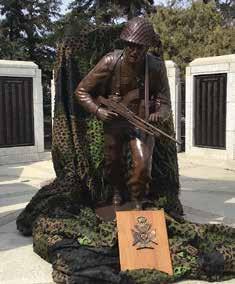
decorating,” said Miraillet. He said Canadians “can be proud of what those veterans did.”
“In a sense, what Kazuska did — going to war, going to France, going from the deep part of Saskatchewan, which is very far away from Calvados and other places,” he continued. “It seems for us it’s a symbol of the capacity of this country, of this democracy, to act in order to defend those values we share in common between the French and Canadians.
“By decorating and giving the Legion of Honour to this man, it’s also a way for us to remember that we realize the Canadian commitments to defend democracy, mili-
tarily speaking,” Miraillet added.
“It’s (the commemorations) a real sense of pride,” said Lt.-Col. Ed Staniowski, retired, from the Royal Regina Rifles. Staniowski was the lead planner for the Royal Regina Rifles Trust for the 80th anniversary and said he saw the statue from conception to completion.
“It’s a real thrill for me to be able to see that the legacy of this great regiment is continuing,” said Staniowski. “When you see it for real, the size of it, the intensity of it, it’s very moving. It’s something that has stuck with me.
“I’ve had a chance to serve with the Canadian Armed Forces in the regiment in various places in the world in several conflicts, and the intensity that is on that statute is what you see on the faces of Canadian men and women when they serve on far off places in the world,” he continued.
Staniowski said it was a thrill to “think we could commemorate” those who fought in the war and “pass on that legacy today, and it’s very important. The world’s a dangerous place… That needs to be remembered. It was a terrible, terrible price that was paid in the Second World War and we don’t want to see that again.”











Moose Jaw soldiers William Gordon Williams and Alexander Manson (Barney) Ross participated in the D-Day invasion of Normandy, France, on June 6, 1944, but their experiences 80 years ago on Juno Beach were nothing alike.
William, better known as Gordon, was born in Moose Jaw on Dec. 5, 1920, to William and Emma Williams, who were married in the United Church in 1910. Gordon was their only son, while they also had two older daughters, Mary and Alice.
Gordon’s father died when the boy was 18.
Gordon completed Grade 8 and worked as a labourer for Smith and Parkhill Building Contractors. He enlisted in the military on June 23, 1940, in Moose Jaw at age 19. Originally, he trained at the Canadian Signals Training Centre and then joined the Regina Rifle Regiment on Aug. 16, 1941, as a rifleman.
He embarked for the United Kingdom from Halifax, N.S., with the 1st Battalion on Aug. 24, 1941. From November 1941 until June 6, 1944, Gordon rose through the ranks to become a sergeant.
Gordon’s war was short, as he was killed in action on Juno Beach
By Jason G. Antonio
on June 6. His mother received a telegraph eight days later saying that her only son had died in service of his country.
He is buried in the Beny-surMer Cemetery, grave 3, row B, and plot 9.
Barney Ross was a long-time employee with the Department of National Defence, as he worked as a senior supervisor of the grounds department at the then-CFB Moose Jaw.
He was a proud, independent, and honest man who believed in the people who worked beside him and for him. He was also quick to recognize his employees’ abilities and use those skills to the best advantage.
Ross joined the army as a young man and served as a transport truck driver during the Second World War. He was eventually called to serve during Operation Overlord and the D-Day landings. He was delivering supplies ashore during the invasion when, shortly after hitting the beach, he came under enemy fire and was shot through the right calf. This limited his ability to press the gas pedal, but he kept going until a second bullet wound to the torso pre-
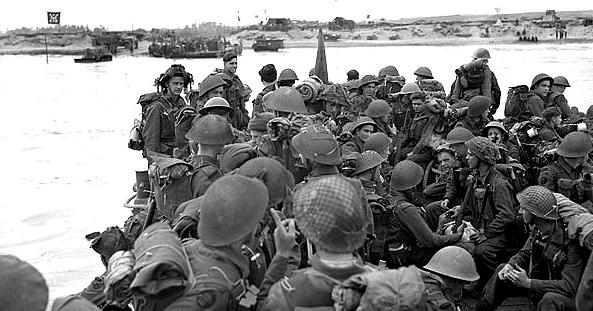

vented him from continuing.
Some troops, seeing that he was incapacitated and the vehicle no longer moving, hauled him out and put him on a landing craft to return to the ships stationed off the landing beach so he could receive medical attention.
Ross never spoke about his time during the war after the military released him from his service. In fact, according to Sue Knox, who worked under the man as a summer student, he was embarrassed that he had been shot and lived while many of his brothersin-arms never returned to civilian life, married or had families.
“He bore those scars for years, but one day (in either 1974 or 1975), while resurfacing the runways in 35-degree (Celsius) heat, while the rest of his crew were shirtless, some in shorts and boots, he wore long sleeves and a collared shirt buttoned almost to the top and was having a difficult time with the heat,” Knox recalled.
Knox asked him why he never took off his shirt to enjoy the sun and acquire a tan during those periods when the base was shut down for summer repairs. This is when Ross told them about the war and what happened to him.
After a few minutes of thought and the guarantee from his work

crew that none of them would mock him for his “untanned hide,” Ross called a work break and explained what he had gone through and the fact he was embarrassed by his wound scars.
“After much reassurance, the crew ensured him that there would be no mocking, snide jokes or comments, and that we were all very proud of the fact that we had his sacrifice to lay claim to our current social freedoms,” Knox said.
After finishing the break, Ross bared his back to the sun and showed his crew the bullet wounds. They then carried on with resurfacing the runways.
He later said that that was the first time in about 40 years that he had ever told anyone outside his family what had happened to him during the Second World War and his service to Canada.
Alexander Manson (Barney) Ross was born in 1923 and died on Nov. 2, 1987. He is buried in Sunset Cemetery.



Jason G. Antonio
Veteran Bernie Dudka was a military policeman guarding the Canadian embassy in Moscow in the late 1980s, which was a dangerous assignment since the country was collapsing as the Cold War was ending.
Dudka and his wife were watching TV in their apartment one evening when they heard gunshots on Kutuzovsky Street — one of Moscow’s iconic roads — below them. The KGB and the mafia were engaged in a shootout, one of many regular fights they were having.
“And all of a sudden, a dump truck pulled up. All these bodies were thrown in the dump truck, and then a street cleaner came by and cleaned the street up and everything,” he recalled.
The next day, he reported the shootout to the Canadian ambassador since it occurred near the diplomatic compound. However, the head of the KGB told Dudka and others that the agency was allegedly filming a gangster flick and there was nothing to worry about.
“They made it all up and everything, but it was real-life stuff,” the retired military policeman said.
On another occasion, Dudka was visiting an open-air food market with his wife and two daughters while a KGB agent trailed them. During that occasion, the agent, Igor, told Dudka three times that he needed to leave the market immediately.
The Canadian told him that they were shopping and would leave soon. However, Igor said that if they didn’t leave, the KGB would forcefully move them.
“So I got mad and said, ‘Good enough, Igor.’ And about 10 minutes after we left, there was a shootout at the exact place we were going to, between the KGB and Russian mafia,” Dudka said. “If we had been there, we would have
been shot.
“I listened to my KGB agent after that,” he chuckled. “(It was just) another day in Russia.”
Dudka also served as an MP in Afghanistan in the late 2000s and early 2010s, where he was assigned to guard dignitaries who visited the Canadian soldiers — people like hockey greats Don Cherry, Bob Probert, Lanny McDonald and Guy LaFleur and musicians Jim Cuddy and George Canyon.
“Anytime there’s rockets coming in, you have to protect these people. It’s interesting to look after these people,” said Dudka, who noted that two or three bombs hit the camp daily. “Their eyes really open up when they see what’s going on over there.”
The retired MP recalled looking after Canyon, who visited on Canada Day in 2008. Canyon was on stage tuning his guitar and had his earpieces in, oblivious to everything happening around him — including the shrill of the rocket alarm.
Dudka recalled furiously waving at Canyon to lie down because the rule was to hit the ground for two minutes and then find shelter.
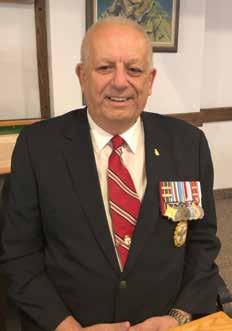
Yet, the musician kept on tuning his instrument, so the MP raced on stage and tackled him.
“He goes, ‘Holy Heck!’ He (also) said other words,” Dudka chuckled.
Canyon never forgot Dudka’s lifesaving actions because when he came to Moose Jaw in 2019, he told the crowd the story of how a 240-pound military policeman tackled him in Afghanistan. He
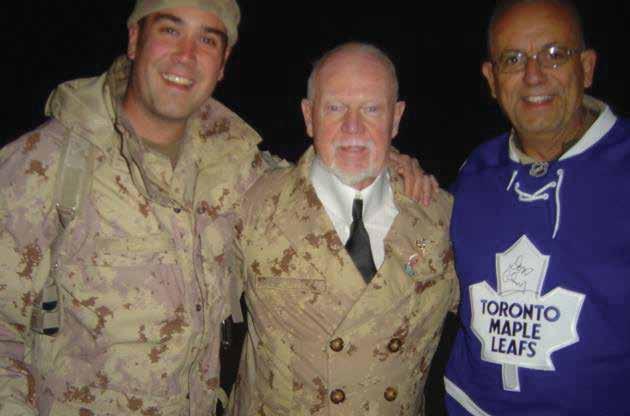
then called out Dudka, who was in attendance.
“So, they put the light on and I waved at him. Afterwards, I got to meet him again. That was pretty good,” the veteran beamed.
Born in Glasgow, N.S., Dudka was 23 when he joined the Royal Canadian Air Force in 1979 as a military policeman.
He was actually working with the Royal Bank of Canada and was set to become a manager. However, he had always wanted to be a cop, but back then, candidates needed perfect vision to join the RCMP. After that rejection, he applied to the military in July and, by October, had received the MP position.

Serving in the military — and as police — runs in the Dudka family, as his uncle and father served in the Provost Corps in the Second World War while his brothers were municipal cops. Dudka, 67, noted that he was thrilled to have joined the military and wouldn’t change how that situation played out.
Dudka worked at several locations throughout Canada and across the world — including in Cario, Egypt and Cyprus — during his career. After 33 years, he retired in 2017 for medical reasons and moved to Moose Jaw, where he made friends with other retired military police officers.






The 80th anniversary of the D-Day invasion of Normandy, France, occured this past summer.
The Moose Jaw Police Service’s Sgt. Chad Scheske joined the Royal Regina Rifles infantry regiment at age 17 in 1992 and served until 2000 before becoming a policeman. He later rejoined the Rifles part-time in 2002 before officially retiring from the military unit in 2010.
“It was fantastic. I was going to university because it was part-time work and then summer employment. And then it allowed me to develop all sorts of skills that I use to this day in policing,” he said.
Scheske did not participate in any military tours when he was with the Rifles. He was already a full-time police officer when Canada began its mission in Afghanistan around 2002 and couldn’t take off a year to serve.
However, in 1995, he trained with others for a United Nations deployment to Yugoslavia before the assignment changed to a NATO mission. However, the military decided the group was not properly trained and chose not to send them over.
Scheske was also working full-time with the regular force army then and said he couldn’t stick around for a non-existent mission since he wanted to earn his degree.
While with the Rifles, Scheske served under Ed Staniowski, a Moose Jaw-born hockey player who competed with the WHL Regina Pats from 1971 to 1975 and then with the NHL’s St. Louis Blues, Winnipeg Jets and Hartford Whalers from 1975 to 1985.
Staniowski was a captain and platoon com-
mander in charge of 30 men when Scheske joined the Rifles. He was promoted several times and became the unit’s commanding officer, retiring as a lieutenant colonel.
It was Staniowski who reached out to the Moose Jaw policeman and asked if he wanted to attend the D-Day ceremonies with other Rifles.
Staniowski recently gave a presentation to the Moose Jaw Board of Police Commissioners about the Second World War-era battle, its significance, and the Rifles’ 10-day itinerary while in France.
“This is an experience that I’m certainly honoured to be able to go on (to pay homage) all those brave men who fought overseas and to walk in their footsteps and see what they went through,” said Scheske.
“And to hear some of their stories that are still perpetuated through the people that go on these tours is really important,” he continued. “As they get older, we need another generation to still speak their stories when they’re not here to speak for themselves. So that’s super important to me.”
Scheske recalled that during the 1990s, the Rifles had many get-togethers to remember the D-Day invasion. Attending those gatherings were dozens of Second World War veterans — such as Cpl. Dennis Chisholm and Lt. William (Bill) Grayson — who regaled the younger members with tales of their time in Europe.
Chisholm — a former Regina Police Service deputy chief — died in 2015 at age 90, while Grayson — the namesake of William Grayson School and son of the founder of law firm Grayson and Company — died in 2008 at age 80.




Scheske admitted that as a young man, he never truly understood what those veterans experienced as teenagers. However, as he grew older, he came to understand that history, the horrors of war, and the amazing feats the veterans achieved.
The sergeant recalled that during a Rifles’ reunion in June 2023, there was only one Second World War veteran in attendance; he died two months later.
While in France, Scheske is also excited to see the Rifles unveil an eight-foot-tall statue near the Courselles-sur-Mer beachhead where the unit landed on D-Day, along with a new plaque commemorating the landing.
“It would be another way to honour those people who stormed those beaches and pressed through and liberated Europe,” he added.




Jason G. Antonio
Emotion filled Staff Sgt. Chad Scheske’s voice as he discussed his trip to France to celebrate the 80th anniversary of D-Day and honour those men who fought — and died — on that beach and elsewhere in Western Europe.
Scheske travelled to Europe in early June with the Royal Regina Rifles’ Trust Fund (RRRTF) as part of Operation CALVADOS, which aimed to commemorate the June 6, 1944, invasion of Normandy and the subsequent battle to liberate France.
The Moose Jaw police officer is a retired sergeant of the Royal Regina Rifles and attended the Tour of Honour after Ed Staniowski, a retired lieutenant colonel and a Moose Jaw-born native, asked him to attend.
Walking on ‘hallowed ground’
“The trip overall was fantastic (and was) a trip of a lifetime. I was honoured to be there,” Scheske told the Moose Jaw Express. “And it was pretty amazing to walk (in) the footsteps of those who were there in 1944. And it’s some fairly hallowed ground that I will certainly remember for the rest of my life.”
What struck Scheske while standing on Nan Green Beach — where the Regina Rifle Regiment landed on June 6 — and visiting other parts of France and Belgium was that most soldiers were between 18 and 20 years of age.
These boys left Canada and trained in England for several years before hopping into landing craft and sailing across the English Channel to liberate a country they had never seen before.
“And as their landing craft hit the beaches, some of their war lasted five seconds. And they paid the ultimate sacrifice to free France and … Europe,” Scheske said, noting the men showed heroism and bravery while completing their tasks.
Those who survived the landing later accomplished an incredible feat by pushing 20 kilometres inland in two days, mainly due to amazing leaders and soldiers willing to follow them, he continued.
A VIP veteran
The RRRTF visited Juno Beach on June 4 but couldn’t return for the 80th anniversary ceremony on June 6 because of circumstances beyond the group’s control. However, what Scheske thought was phenomenal was that 99-year-old William Seifried — who landed at Juno — walked the beach with members of the Royal Regina Rifles in attendance.
Seifried was also treated like a very important person; he had an entourage with him and met Prime Minister Justin Trudeau.
“So us average folk didn’t really get in to
talk to him because he was well taken care of,” chuckled Scheske.
War stories
Although the Moose Javian never conducted any research before travelling to France about Rifle members who died on the beach, he recalled listening to veterans in the 1990s who survived the invasion and subsequent Battle of Normandy.
One member whose story he remembers is Denis Chisholm — Regina’s former deputy police chief — who recalled walking across a small footbridge over the Leopold Canal in Belgium, falling into the water, sinking and attempting to strip off his gear to escape. Luckily, another soldier pulled him out.
“I really wish that when I was in the ’90s (and was) … that much younger that I had paid more heed to their stories because now that I’ve been there, (I) can put their stories (into context),” Scheske said.
The Tour of Honour group eventually visited the Leopold Canal and saw just how close the Canadians and Germans were during combat. The battle occurred in September and October 1944 and caused over 200 Canadian casualties, including 45 dead.
While travelling in France, the group encountered two Frenchmen who had interesting stories about their connection to the Second World War.
One man’s father fought with the French army and was captured by the Germans at Caen. After the Canadians liberated that city, the father returned weighing 100 pounds, and a year later, his son — who pretends to be a veteran because of his aged looks — was born.
The second man was seven years old — he’s now 87 — when the Canadians landed and remembers the Regina Rifle Regiment preparing to attack a well-fortified position at the Ardenne Abbey. He recalled his father saying they needed to hide in their basement because the fighting was about to start.
The tour group was so amazed by the man’s story that one of the Rifles’ commanding officers gave him a challenge coin to honour him.
Leadership roles
Scheske brought back a bottle of sand from Juno Beach and plans to give small amounts to every MJPS officer in a leadership position and explain how important that material is. He pointed out that senior officers with the Rifles led their men from the front and had high casualty rates.
“It’s important for your leadership within
this organization to know that just because you’ve been promoted … doesn’t mean that you’re not there with your people under you striving and hoping to do the best for them,” he said.
Numerous war dead



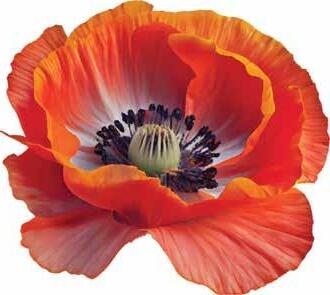


Besides Second World War locations, the group also visited places with connections to the First World War, such as the Menin Gate monument and Tyne Cot Cemetery — both in Ypres, Belgium.
The monument lists the names of more than 55,000 Commonwealth soldiers — including 6,000 Canadians — who died and have no known graves, while the cemetery is the largest war cemetery worldwide, with over 11,000 headstones and 35,000 names on wall plaques.
“It’s really sobering. And the amount of casualties from the First World War are staggering in the amount that were never found and lost to the mud and lost to the artillery,” said Scheske.
The officer also visited and touched the Vimy Ridge monument, which lists 11,250 Canadian soldiers with no known graves. After seeing the ridge, Scheske gained a better idea of why that area was so important to the Allies — the high ground gave good views of the surrounding area and made it more easily defensible.
An emotional trip
Reflecting on his trip, Scheske said that many emotions flowed while he was there, whether it was visiting cemeteries, seeing monuments or participating in candlelight vigils.
“Someone had to play the bagpipes, and the sunglasses come on, and the tears roll down your face,” he remarked. “So yeah, it’s overwhelming.”
The policeman praised the Europeans for their commitment to honouring Canada’s fallen soldiers, sailors and airmen, whether it’s maintaining war cemeteries or holding three-day celebratory events.
“Yeah, standing on Juno and standing on Vimy, where some of the greatest sacrifices were made, it’s emotional,” Scheske added. “No doubt.”









The Moose Jaw Public Library and Archives is a wonderful place to allow your mind to wonder. Old Obituaries offer interesting morsels of Moose Jaw history, like this Obituary.
Monday, December 4, 1939, the Moose Jaw Times Herald.
HEADLINE: Veteran Nurse of U.S. Civil War Honored in Death by Many Citizens
“A simple ceremony was observed Saturday in memoriam to Mrs. Minerva Ann Greenhill (r 262 Athabasca East), 97-year-old resident of Moose Jaw until her death – one of the few remaining veterans of the United States Civil War.
“Many friends gathered to pay final respects to the deceased, one-time associate of General Robert E. Lee, head of the South’s Confederate Army. Mrs. Greenhill, an eye witness and actual participant of many historic battles of the Civil War, died early Thursday evening.
“She was born Minerva Ann Cannon in 1842 at Fort Royal, Warren County in the Shenandoah Valley, of one of the first families of Virginia and 19 years later began a colourful career as a nurse and messenger with the Confederate Army on the march.
“During three hectic years she carried love letters from sweetheart to soldier, and messag-
es of great importance through enemy line and from one ballet point to another, concealed in the hollow heel of her shoe. She was captured three years after the outbreak of hostilities, and strangely enough, was later married to George W. Kisner, one of the six men sent to carry her across the Mason and Dixon line into captivity.
“That marriage took place March 17, 1865, five years before the outbreak of the Franco-Prussian War, which is ancient history to most people living today. A few years after Mr. Kisner’s death, the deceased married Mr. Greenhill at Kansas City. She was predeceased by him at Hedley, B.C., (a gold mining town in southern B.C.) in 1906, but had already added luster to an unusual life by a spell of gold mining in the British Columbian hinterland.
“She had been a resident of the Dominion (Canada) for the last 50 years. In 1911 she moved to Limerick, Saskatchewan from Penticton, B.C., and after nine years resident in the Limerick District, she came to Moose Jaw, where she had resided ever since.
“The services Saturday, held in Broadfoot’s funeral home, were marked by the singing of “Abide With Me.” Francis Stevenson accompanied the congregation and the funeral oration
“His duffel bag lay ready at the door… Innocence, youth and virulence soon to be challenged.
A mother rubs her burning eyes afraid to shed a tear as she faces the reality that her young son is off to war. Mere man, still boy with hopes of love and more…
Beckoned to the fields stirred by the passion within
That wraps it’s blood-thirsty hands around his soul awakening the soldier to war.
The cost was much greater… A sacrifice to bear.
was taken by Reverend Geoffrey Glover of St. Andrew’s Church, United Church of Canada.
“Pallbearers were: John Rouatt – farmer, h 1116 Clifton Ave; Frank Latta – h 1061 Algoma; Ernest Jenner, 262 Athabasca Street East – relative; Frank Morris, h 2-80 Home Street East; H. Stark, no address; Joseph S. Allison, Assistant Attendance Officer, h 240 Athabasca Street East.” (Many of these houses are occupied today.)
Notes: I was unable to find a record of Mr. Greenhill in the Hedley, B.C. cemetery. The name ‘Cannon’ is common in the Fort Royal, Warren County in the Shenandoah Valley.
Minerva Ann Greenhill is buried in Block 12, Lot 10, Grave 5 in the Rosedale Cemetery. There is a Headstone. (Information provided by the Moose Jaw Genealogy Society)
Minerva resided at 262 Athabasca East, the home of Ernest Jenner, a relative. The family connection is unknown. There are a number of ‘Jenner’ folks as buried in Rosedale cemetery including Ernest (d 1985); and his probable relatives, Florence and Gordon Jenner.
MJ Story US Civil War Confed Army Obit 20240421 02 file doubt.”
One life; a thousand; ten-thousands and more
lifeless bodies - blood-stained never returning from war.
Heroes to a nation…
Names etched to proclaim Freedom from tyranny In God’s precious name. Lest we forget; we remember them!”
Unknown author





People are the heart and soul of
The Royal Canadian Air Force (RCAF) has a great history and exciting technology, but the people are the heart and soul of the organization, a former Snowbirds commander says.
Retired Lt.-Col. Maryse Carmichael was the guest speaker during a veteran’s luncheon that the Royal Canadian Legion Branch No. 59 held on Oct. 10.
Carmichael is a 22-year veteran of the RCAF and logged more than 3,500 hours of flight time. She flew with the 431 Air Demonstration Squadron — the Snowbirds — and was the first female pilot in the world to fly on a military aerobatics team. She was also the team’s first female commander.
The retired lieutenant colonel was inducted into the Canadian Aviation Hall of Fame in 2022.
“My career … has been filled with incredible memories and the privilege of working alongside dedicated, courageous and highly skilled men and women,” Carmichael said.
“When I reflect on what the RCAF means to me, it is really the people that I think of first.”
Carmichael singled out the aircrews who had “made, unfortunately, the ultimate sacrifice” over the decades and those who served today and continued to demonstrate the same commitment as their forebears.
The RCAF was born on April 1, 1924, when the aviation world was still young, and eventually, the small pioneering group grew into one of the most respected air forces in the world, she continued. The organization was built on the dedication, innovation and bravery of its people.
“We must never forget that the foundation of today’s RCAF was laid in the skies over Europe during the Second World War,” said Carmichael. “Over 200,000 Canadians served in the RCAF during that conflict and nearly 18,000 people paid the ultimate price.
Jason G. Antonio
“Many of them were young, flying dangerous missions over enemy territories in aircraft that pushed the limits of technology at the time,” she continued. “Their courage and the sacrifices they made ensured that future generations could live in peace and freedom.”
As a pilot, Carmichael said she always felt a connection to those “brave souls” who came before her.
She pointed out that the RCAF’s participation in pivotal events like the Battle of Britain and D-Day was not just about the hardware but about the people — with families, hopes, and dreams — who flew them.
“These are the stories that inspired me and so many others to join the ranks and contribute to this proud legacy,” she remarked.
Carmichael is grateful for what she accomplished, whether it was training students in Moose Jaw, working with fighter command, or leading the Snowbirds. She noted that she was regularly surrounded by people who dedicated their lives to the cause, qualities that are still apparent in a world of evolving challenges.
“This is the hallmark of the RCAF, (is) its ability to adapt and excel in the face of ever-changing global threats, from the Cold Warera to the modern-day peacekeeping missions, humanitarian operations and the NATO deployments,” she said.
Carmichael noted that the RCAF’s commitment to innovation has been essential to its success, while she has been fortunate to witness first-hand how that innovation has shaped Canada’s aerospace industry. That industry has thrived due to the strong relationship between the military and civilian aviation.
The air force has always been at the forefront of pushing technological boundaries, and as that technology has changed, the organization has also evolved to embrace

new capabilities and prepare for the future, she said. The organization has done this with the same pioneering spirit that it had 100 years ago.
“But we’re here today not just to celebrate history or the technology. We’re here to celebrate the heart and soul of the RCAF — its people … ,” Carmichael said, noting the veterans were the backbone of the organization, made the necessary sacrifices and shared the camaraderie of serving together.
“… it’s because of you that the RCAF stands tall today.”
The air force has grown, adapted and risen to the many challenges of every decade, every new conflict and every new threat, but what hasn’t changed is its “unwavering commitment” to defending Canada, supporting its allies and

protecting common values, said Carmichael.
Whether it’s peacekeeping missions, humanitarian efforts at home and abroad, or combat operations, the RCAF has repeatedly demonstrated its versatility, professionalism and dedication to serving Canada and the world, she continued.
“As we look to the future (and potential conflicts), I have no doubt that the Royal Canadian Air Force will continue to inspire and lead … (and) meet those challenges head-on just as it has done in the last century,” Carmichael added.


People who join the military usually develop a special and long-lasting relationship with others who served, as evidenced by three Moose Jaw veterans who affectionally call each other a “meathead.”
Jim Alexander, Bernie Dudka and Sherri Wedel all served as military police (MP), while they all either finished their careers in Moose Jaw or moved here in retirement. The trio recently discussed their time with the Canadian Armed Forces and the friendships they developed with each other and others.
“One of the biggest things about the military is the comradeship. That never goes away. You can have friends all over the world,” said Wedel, who noted that she and Dudka worked together at Cold Lake, Alta., while she was stationed in Winnipeg when Alexander was at Shiloh, Man., and the two men served in Afghanistan.
Said Dudka, “It’s a big family, and it’s something you’ll never take away from the military.”
Alexander agreed, saying the military is a “unique family and a unique culture.”
“And the weirdest thing for me is when I retired to Moose Jaw (and ran) into everybody — well, these guys,” he said. “We have a group of five or six of us who are all military police, and all served here or retired here.”
During the conversation, the trio called each other a “meathead,” a word that they insisted was more humorous than insulting.
The word arose during the Second World War when MPs controlled intersections during campaigns in Western Europe to ensure traffic flowed smoothly. Whenever a convoy moved to the front, a crew commander or officer would tell a soldier “to go meet the head” because all anyone saw of the dug-in MP was his helmet.
Jason G. Antonio

“So a lot of people think it’s an insult to the military police, but actually it’s a compliment,” said Alexander.
When asked whether that word of endearment was spelled meethead or meathead, Dudka replied, “It depends on how you look at it. We look more at it as m-e-a-t-h-ea-d.
“We’re all meatheads; we’re proud meatheads,” he added, with Alexander and Wedel agreeing.
Alexander joined the military because his father and grandfather had served in the forces and he felt called to serve, while Wedel joined because she had always wanted to be a police officer and an MP spot opened up before positions in other police forces.
Dudka also wanted to be a police officer because his father and uncle served in the Provost Corps during the Second World War, while his brothers also became cops. He noted that his father was his biggest influence in joining the military.
Dudka’s father, Stanley, was one of several soldiers who helped

convict notorious German General Kurt Meyer during the Nuremberg War Trials. Meyer led the fanatical 12th SS Panzer Division Hitlerjugend and ordered the killing of 20 Canadian prisoners of war at the Ardenne Abbey in June 1944 because the German unit had no resources — or food — to care for the PoWs.
The elder Dudka — who was with the North Nova Scotia Highlanders — had also been taken prisoner, but because he had three

chocolate bars, convinced Meyer to release him and three others.
“My dad had three or four cousins that were in there, and (the Germans) told my dad, ‘OK, pick the people you want to save.’ And my dad picked out three of his cousins,” said Dudka.
“They pulled to the side, and right after that, Kurt Meyer went behind each (remaining PoW), put a Luger at the back of their head and shot them.”
Stanley later escaped, but not before breaking into Meyer’s office and taking an SS flag and the murder weapon, which was used as evidence during the trial.
Veterans — especially those who fought in Afghanistan — can usually recognize each other by their battle scars or, more commonly, by the medals on their chests, the MPs said. Since over 80,000 soldiers received a medal for fighting in the West Asian country — some received multiple bars for multiple tours — they usually approach each other to learn about when and where the other served.
The MPs added that with how long each served — Alexander, 34 years; Dudka, 33 years; and Wedel, 31 years — they collectively have almost 100 years of service to Can ada.







